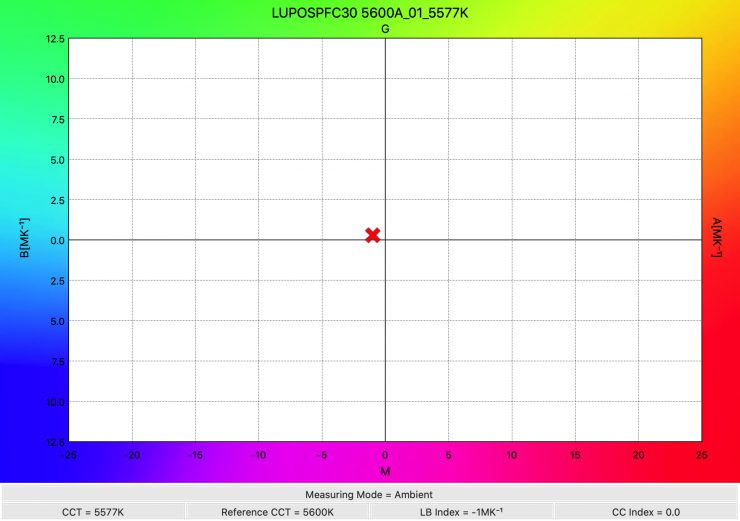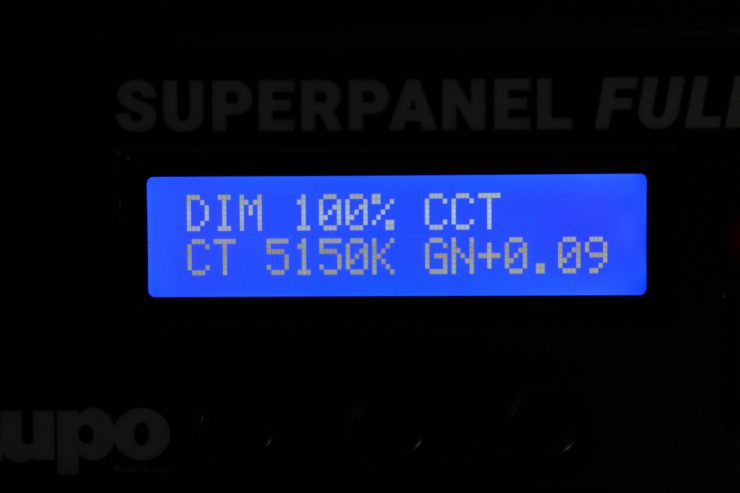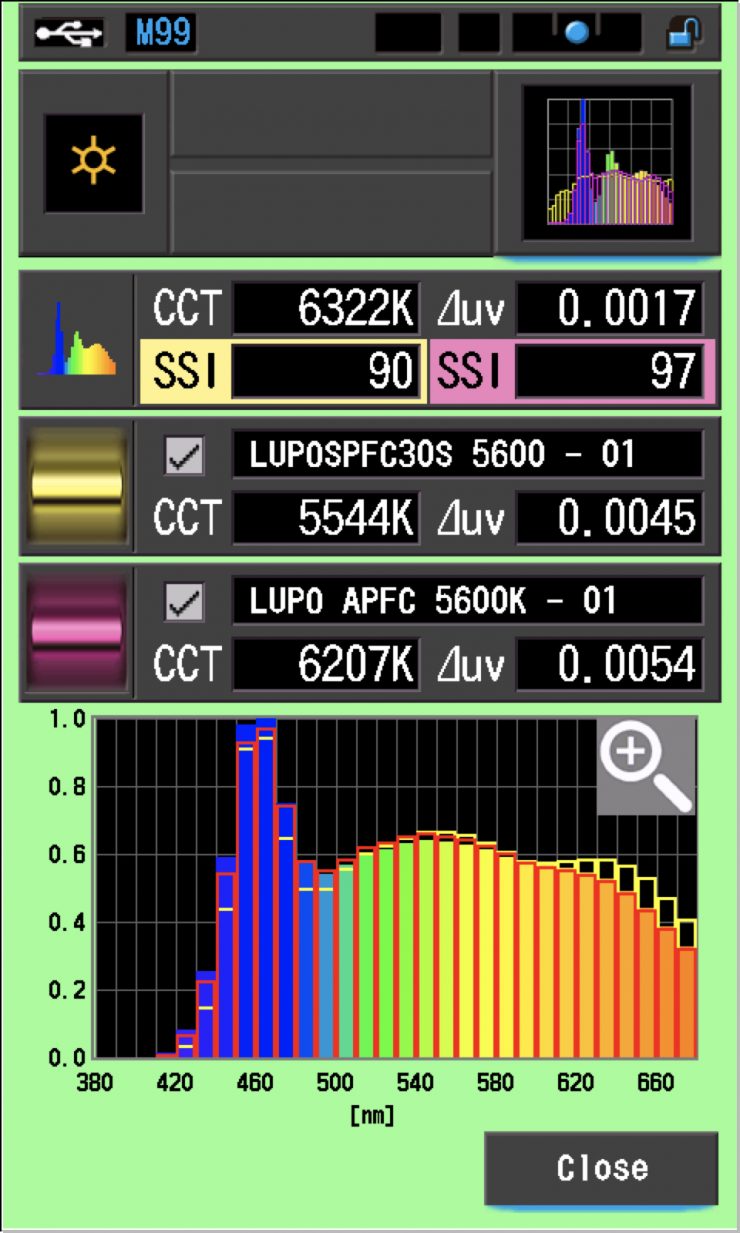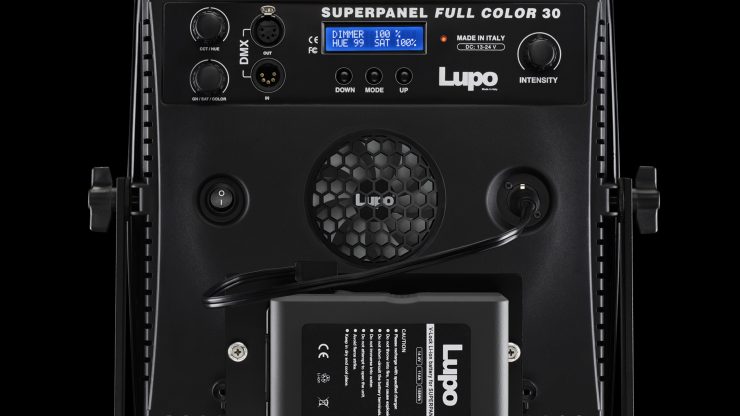
The Lupo Superpanel Full Color 30 is a bit of a rarity when it comes to RGBWW panels. Most 1×1 RGBWW lights tend to feature built-in diffusion panels, but the Lupo doesn’t.
I have been a big fan of the Lupo Superpanel series. They are high output, color-accurate, and well made 1×1 panel lights that are hard to beat at their price point. What is also nice is that all of the Superpanel lights match really well together so you can use them in combination without getting any nasty color surprises.
I previously reviewed the Lupo Full Color 30 Soft on the website. This was Lupo’s first foray into RGB lighting and it followed a growing trend of lighting manufacturers using this technology.
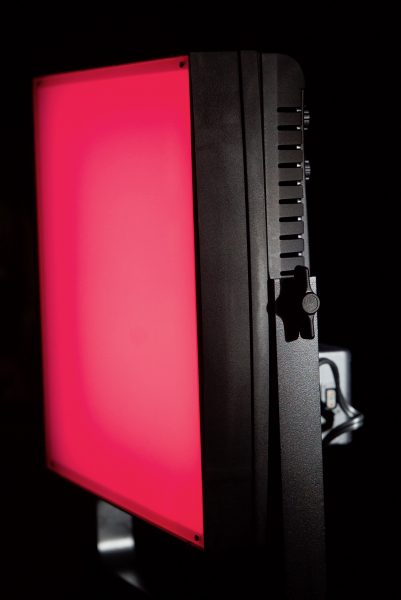
So why make two versions of the same light? Well, quite simply, if you need output the Full Color 30 is going to give you that in spades.
Lupo claims that it’s Superpanel Full Color 30 is the most powerful RGBWW
LED panel in its category. Lupo states that the Superpanel Full Color 30 can output more than 13,000 Lux at a distance of 1 m. I will put that claim to the test.
The Full Color 30 also has a very narrow beam angle and it doesn’t have an in-built diffusion panel. While it does have similarities with the Full Color 30 Soft, it is a completely different type of light.
So what can the Superpanel Full Color 30 do?
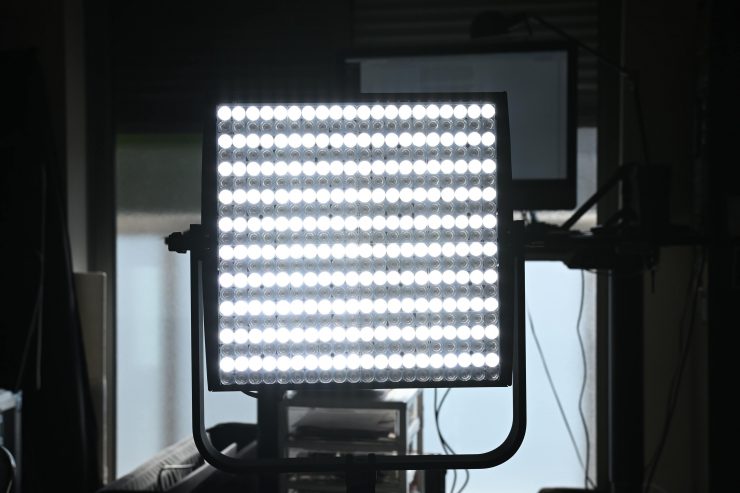
The Superpanel Full Color is kelvin color adjustable from 2800K to 10000K with a claimed CRI and TCLI of 95. With the addition of Full Color (RGBWW) technology, you can also choose to create a variety of colors depending on your requirements. The light has four modes it can run in:
CCT Mode
The light can be set to any Kelvin color temperature from 2800K to 10000K. There is also the ability to have full control over adjusting green and magenta.
RGBWW
In the RGBWW mode, you can control red, green, blue and white independently to produce a range of different colors.
HSI
HSI mode allows you to have full control over hue, saturation, and intensity of any color.
Presets and Special Effects
The Superpanel Full Color 30 has a collection of preset filters and special effects that you can quickly use on the set to create interesting lighting effects.
The Full Color 30 special effects mode it is limited to just four effects:
Strobe – Party – Cop Car – Disco
You can change parameters for all of these effects such as frequency, intensity and effect speed. All the effects work as advertised, and while it’s not something I’m likely to use often, it’s good to know you have them at your disposal.
In the Preset Mode, there are 19 presets you can use, 14 factory presets and 5 user presets.
The factory presets are:
Red – Green – Blue – Soft Pink – Purple – Gold – Orange – Diva Green – Caribbean – Pastel Blue – Cerulean – Lavender – Magenta – Strawberry
To store your presets, you can be in either CCT/HSI or RGBW modes. Once you have created the light you want to store as a preset, you simply press the Up and Down buttons at the same time. You then use those same buttons to find where you want to save the preset and press the Mode button to save. The only problem with the User Presets are you can’t rename them, so if you store something you would have to write down what it is to remember what is stored there.
It can be a hard or soft source
The nice aspect about the Full Color 30 is it doesn’ feature a built-in diffusion panel like so many other 1×1 RGBWW lights. This allows you to use it as a hard light when you need it, but you can then diffuse it or bounce it when you want to create a softer source.
Having a light with a built-in diffusion panel is nice, but it isn’t nearly as versatile as a fixture without.
Physical size and weight
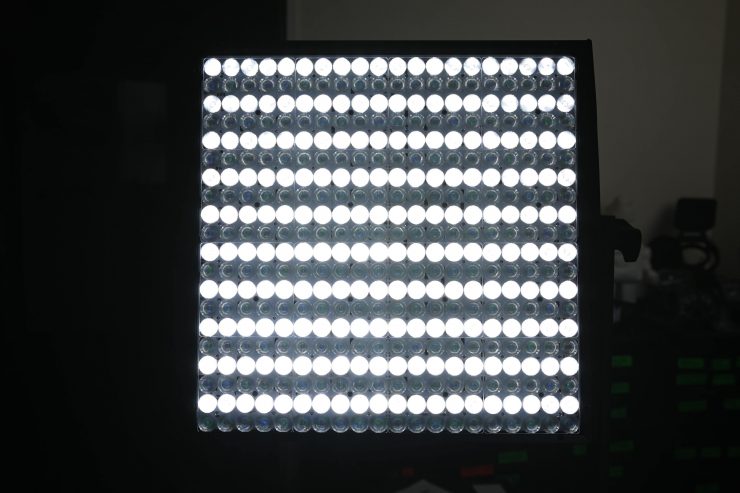
The Full Color 30 has physical dimensions of 335mm x 320mm x 100 mm (13.18″ x 12.59′ x 3.93″) and weighs in at 3.7kg (8.15lb). With the power supply attached it tops the scales at 4.3kg (9.47lb). This is exactly the same as the Full Color 30 Soft.
| WEIGHT | |
| Lupo Superpanel Full Color 30 | 4.3 kg (9.47 lb) With power supply |
| Lupo Superpanel Full Color 30 Soft | 4.3 kg (9.47 lb) With power supply |
| ARRI S30-C | 7.8 kg (17.2 lb) Power supply weighs: 2.5 kg (5.5 lb) |
| Litepanels Gemini 1×1 Soft | 5.31 kg (11.71 lb) |
| Luxli Timpani | 3.37 kg (7.43 lb) |
| Rayzr MC120 | 3.63 kg (8 lb) |
| Falcon Eyes D-S811 RGB 1×1 | 9.26 kg (20.41 lb) |
| FotodioX Pro FACTOR Prizmo 150 | 10.12 kg (22.3 lb) |
Power draw
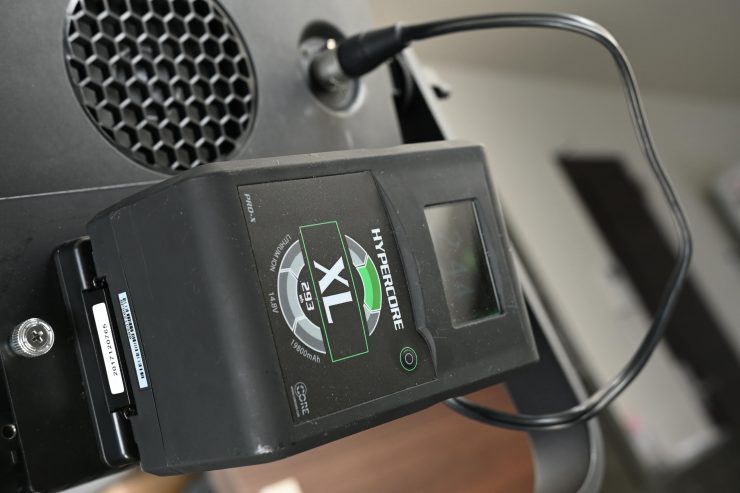
The Superpanel Full Color 30 draws 200W (DC supply from 14.8 V to 24 V) which makes it more difficult to run remotely off camera batteries. Lupo recommends that you use a 230 Wh battery. Unfortunately, if you travel a lot on planes you can’t take batteries over 160Wh. This doesn’t make this light a very travel-friendly solution, especially if you need to run lights remotely without mains power. One solution would be to use two 150Wh Hawk-woods Mini V-Lok batteries on a dual battery plate.
You need to keep in mind that the Superpnal doesn’t come with a battery plate as standard, it is an optional extra.
So how does this power draw compare to other 1×1 RGBWW fixtures? Below you can see.
| POWER DRAW | |
| Lupo Superpanel Full Color 30 | 200W |
| Lupo Superpanel Full Color 30 Soft | 200W |
| ARRI S30-C | 200W |
| Litepanels Gemini 1×1 Soft | 200W |
| Luxli Timpani | 120W |
| Rayzr MC120 | 118W |
| Falcon Eyes D-S811 RGB 1×1 | 200W |
| FotodioX Pro FACTOR Prizmo 150 | 150W |
As you can see, most of the 1×1 RGBWW lights draw 200W. The Luxli Timpani, Rayzr MC120, and FotodioX Pro FACTOR Prizmo 150 are the only ones that can be run off a single flight safe camera battery.
This is something to keep in mind if you fly a lot.
Display and controls
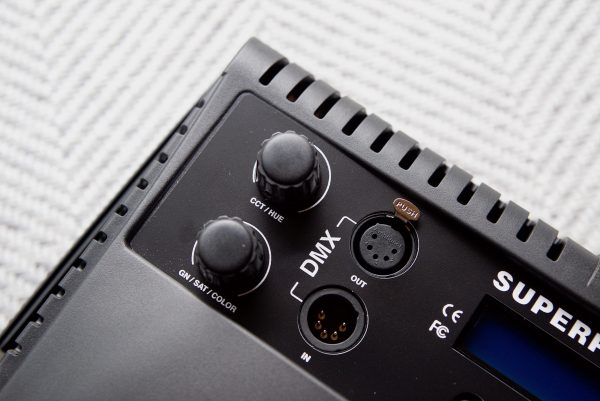
The Full Color 30 has a simple digital display on the back of the light that lets you see and change the settings for intensity, color temperature, color mode, green/magenta adjustments, dimmer curves, special effects and DMX channels. Just like other Lupo Superpanels, the controls for the Full Color 30 are simplistic, but with the newly added features, It does make controlling the light a little more complicated. I don’t necessarily think this minimalistic approach to the control layout works as well as it could on the Full Color 30. You really do need to read the instruction manual to figure out how to make changes.
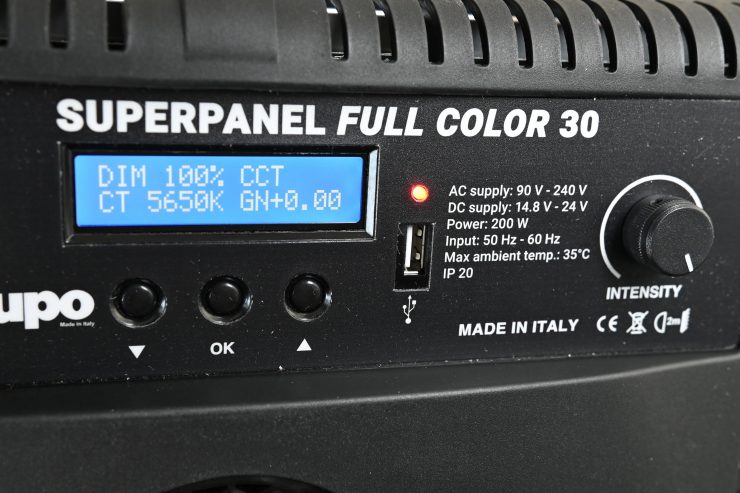
While controlling the intensity and Kelvin color temperature still remains simple to do, once you need to enter other operation modes and make changes it becomes a bit of a memory game. Due to the limited controls on the fixture, you find yourself having to press combinations of buttons to make any changes. I would have preferred to have seen dedicated buttons added for HSI, RGBW, and the Special Effects Modes. This would make it far quicker and easier to use the light. I would have also liked to have seen some sort of wi-fi or Bluetooth app and control made available for the light. This would have made controlling the RGBW and HSI modes a whole lot easier.
In saying all of this, like any new product you get, it always takes time to become familiar with its operation and use.
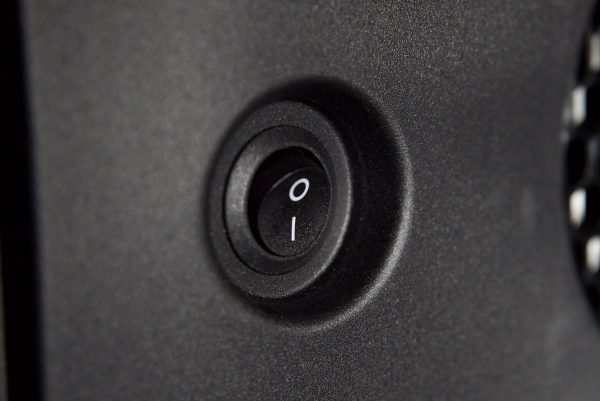
The Superpanel has a recessed on/off switch, a color temperature adjustment dial, a DMX In and Out, a dimmer dial, and a simple LCD display screen with three buttons.
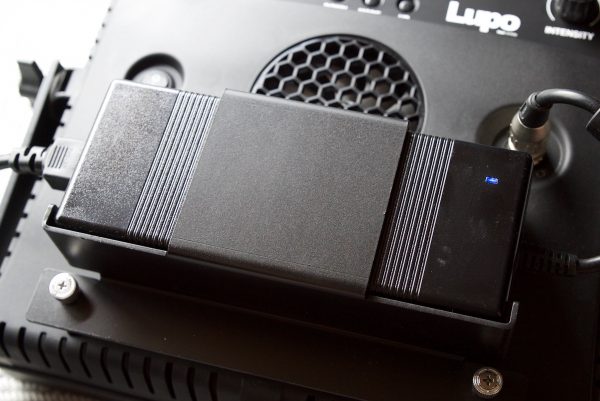
The light has a bracket you can attach that holds the AC power supply firmly in place, and this can be swapped out for a V-Lock battery plate if you need to power it remotely.
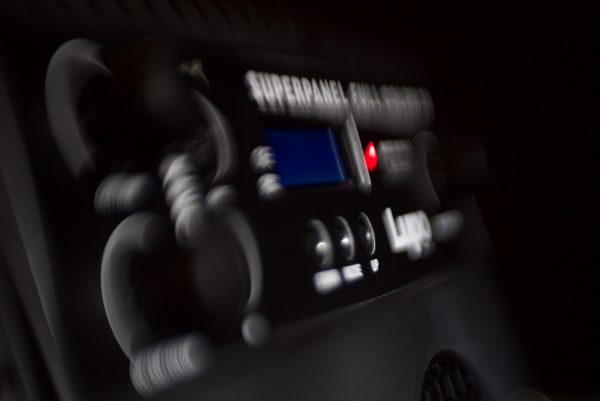
The light is fully dimmable from 1-100% in one percent increments, and you can also adjust the Kelvin range in one-kelvin increments for precise color temperature.
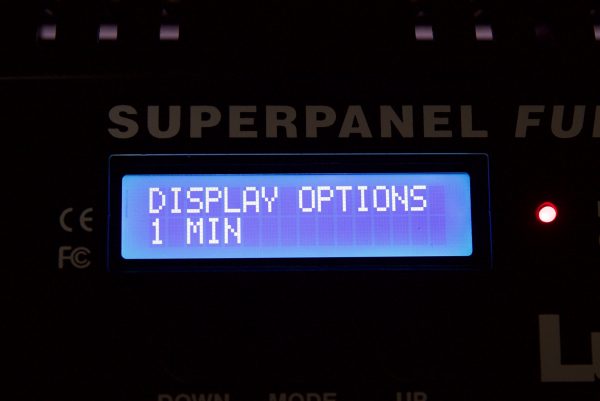
What I liked about the LED display is that you can set it to turn off after a select amount of time so you don’t emit any unnecessary light, this is handy if you are working in dark environments. By touching any of the dials or buttons the display’s brightness comes back on.
The light has a 1/4 20″ threaded hole on the top and the bottom of the light for attaching the optional barn doors.
Build Quality
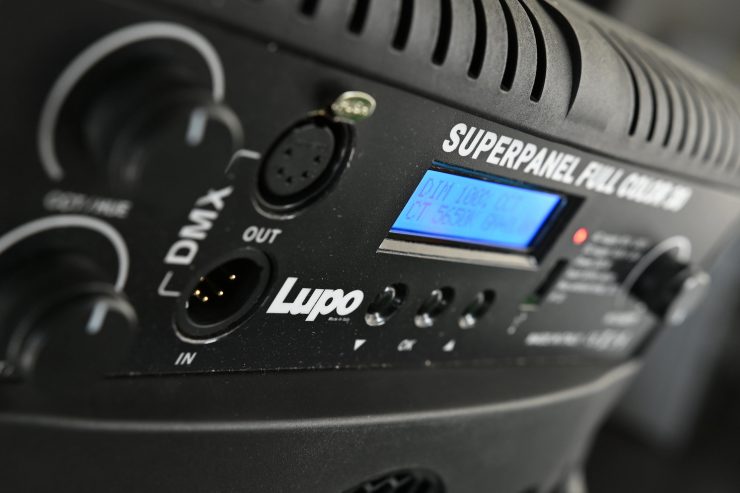
Lupo lights are very consistent when it comes to build quality. Lupo concentrates on making its lights robust and easy to use. They are not fancy-looking lights, they are designed to be workhorses and not mannequins.
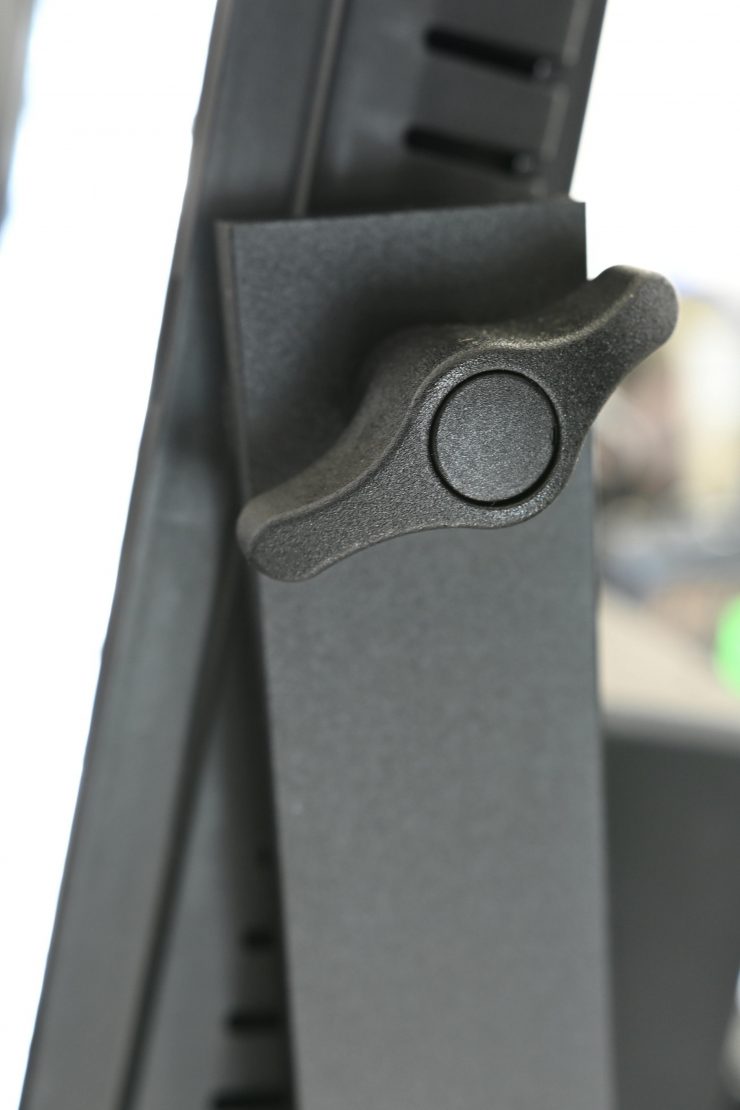
The yolk frame is solidly constructed and the locks on the yolk tighten down very securely.
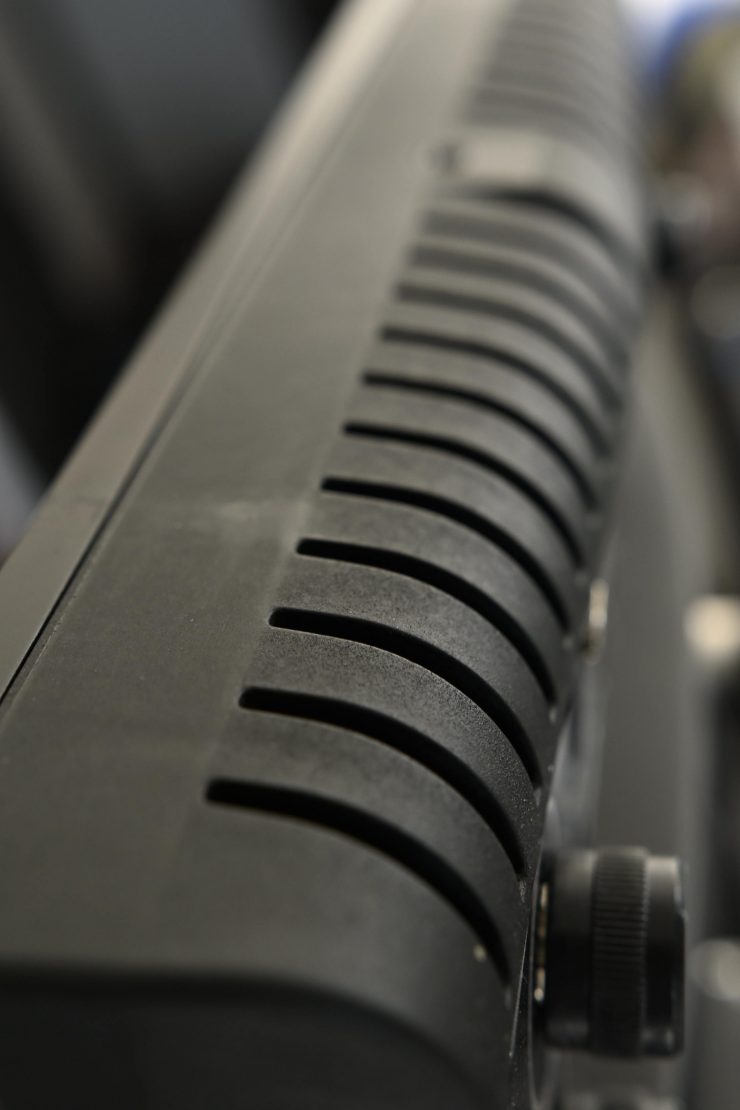
The casing of the fixture is made out of reinforced technopolymer and feels fairly robust. It is matte black in color which is good because it doesn’t reflect any light. The only problem I found with the finish on the casing of the light is it is very prone to scratches. While this is more of a cosmetic issue, than a build quality issue, some potential buyers may not like this.
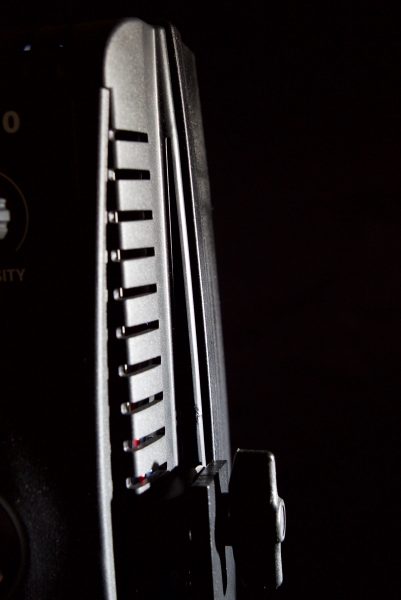
It will be interesting to see how reliable the Full Color 30 will be over time. From using other Superpanel lights over the last few years I have found them to be very reliable and robust.
The only thing that slightly concerns me about the Lupo Superpanels is that their recommended ambient operating temperature limit is just 35°c. That is not that hot, especially if you are using the light outdoors on a hot day.
I have had several LED panel lights (not Lupo’s) that ran really hot and ended up dying after only a year or so of use. If the LED light you are using is really hot to touch then there is a good chance it isn’t being cooled correctly and it could end up dying long before it should.
Beam Angle
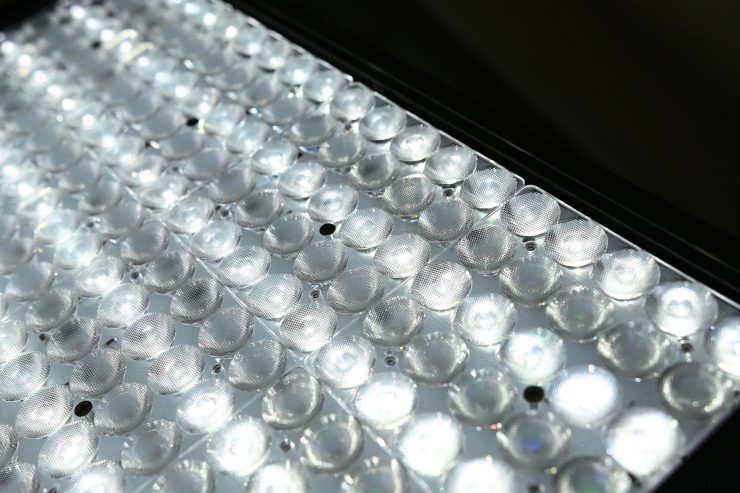
Unlike the Full Color 30 Soft that has a very wide 115-degree beam angle, The Ful Color 30 has a very narrow 40-degree beam angle. If you do want to use it for interviews you will need to use a softbox, some kind of diffusion, or indirectly bounce the light.
What is nice is that if you use the Full Color 30 and Full Color 30 Soft together, you can just attach the optional 40-degree snap grid from DoPChoice to the soft version to achieve the same beam angle.
How does this beam angle compare against other 1×1 RGBWW fixtures?
| BEAM ANGLE | |
| Lupo Superpanel Full Color 30 | 40° |
| Lupo Superpanel Full Color 30 Soft | 115° |
| ARRI S30-C | 110° |
| Litepanels Gemini 1×1 Soft | 95° |
| Luxli Timpani | 78° |
| Rayzr MC120 | 120° |
| Falcon Eyes D-S811 RGB 1×1 | 61° |
| FotodioX Pro FACTOR Prizmo 150 | 120° |
As you can see, the Lupo Superpanle Full Color 30 has a very narrow beam angle compared to most of the other fixtures on this list.
Fan
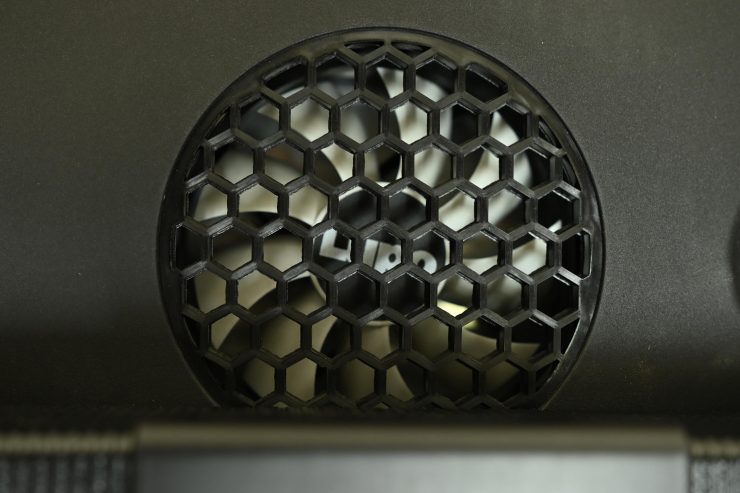
Like other Superpanel lights, the Full Color 30 has an inbuilt fan to keep it cool. RGBWW LED’s run a lot hotter than conventional LEDs and therefore they need to be used in conjunction with fans or heat sinks to keep them cool.
The fan on the Full Color 30 is barely audible, but it can get a little bit warm. Just like other Superpanel fixtures, you can turn the fan off, but if you do the maximum intensity level is limited to 50%.
Photometrics
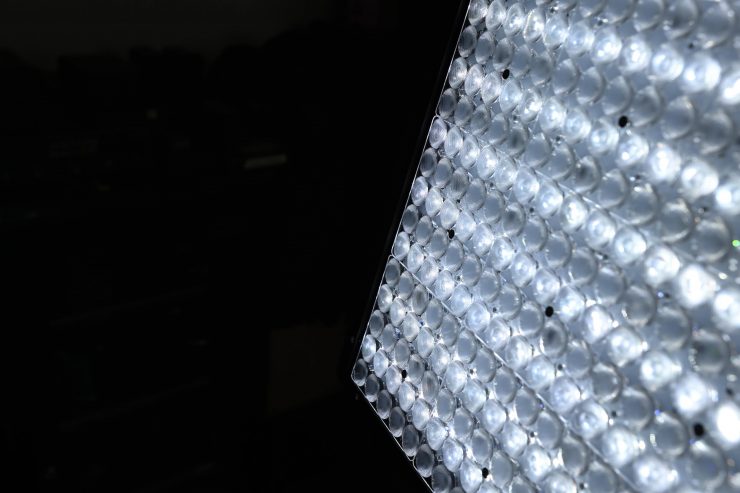
So now let’s get to the photometric results. I always test lights in this way so that I get a reference to how they compare to other fixtures. Results only tell part of the story and should never be used alone to judge a light. I have found from extensive testing over the years that certain lights that have good photometric results don’t always look good, and lights that have worse photometric scores can sometimes look better than their results indicate.
Output & Kelvin color temperature accuracy
I tested the Lupo Superpanel Full Color 30 at a variety of Kelvin color temperatures with a Sekonic C-800 Spectrometer to find out how much output the light had and how accurate the Kelvin color temperature reproduction was. All readings are taken at a distance of 1m (3.28ft) in a controlled environment.
5600K
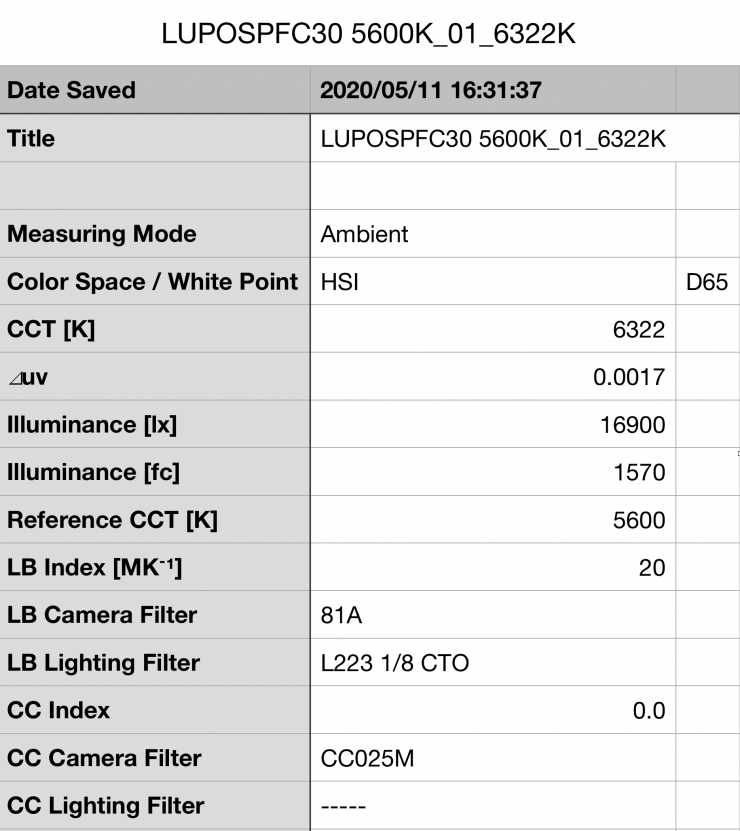
Above you can see the light recorded an output of 16900 lx 1570 (fc) when set at 5600K and run off mains power.
This output was extremely impressive for an RGBWW 1×1 fixture. It was also a lot higher than the 13,000 lx output that is claimed by LUPO.
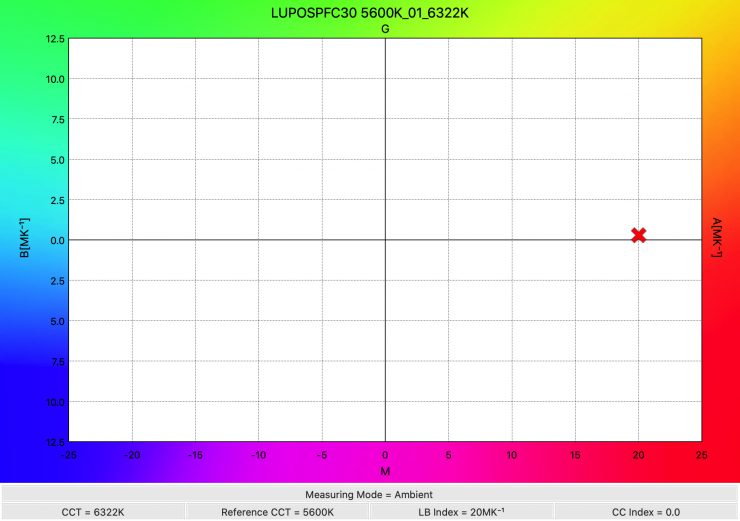
The LUPO produced a Kelvin color temperature of 6322K. The Superpanel had a CC Index score of 0. The 6322K reading was way off for replicating a 5600K source.
In terms of output compared to the LUPO Superpanel Full Color 30 Soft, it was a whopping 286% brighter.
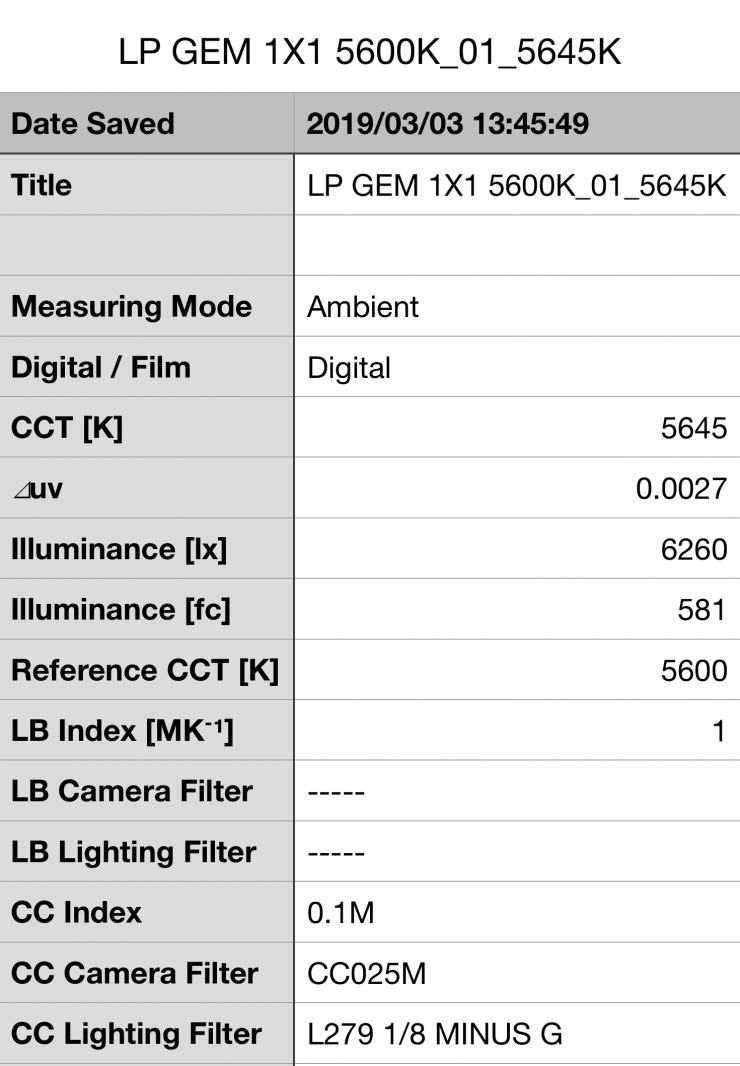
So how does that compare to one of its direct competitors the Litepanels Gemini 1×1? Above you can see the results from the Litepanels. The Litepanels has 170% less output than the Lupo. However, you need to clearly note that the beam angle of the Gemini (110°) is way wider than the 40° of the Lupo.
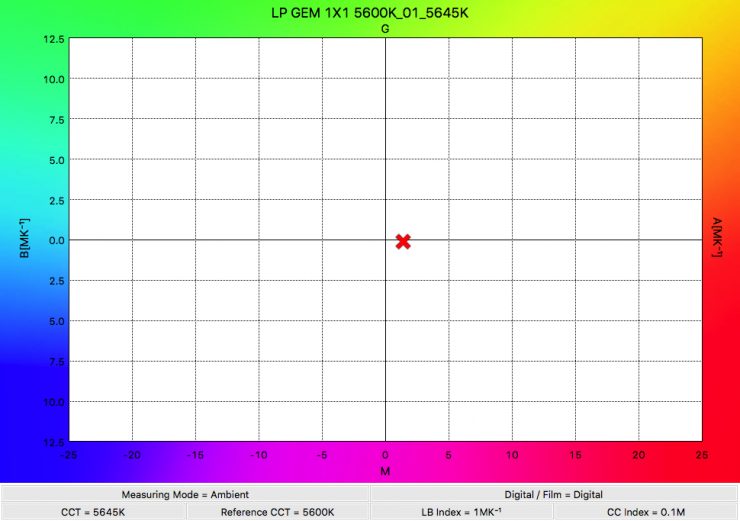
The Kelvin color temperature of the Gemini 1×1 at 5600K was 5645K, which was a lot better than the 6322K recorded by the Lupo. The Gemini had a CC Index score of 0.1M
Here is how the 16900 lx output and 6322K Kelvin color temperature I measured from the LUPO compares to some other RGBW 1×1 fixtures I have reviewed, including Lupo’s own Superpanel Full Color 30 Soft.
| Lupo Full Color 30 | Lupo Full Color 30 Soft | Litepanels Gemini 1×1 | ARRI S30-C | Luxli Timpani | |
| Output | 16900 lx | 4380 lx | 6260lx | 5950lx | 3380lx |
| Kelvin Color Temperature | 6322K | 5423K | 5645K | 5821K | 5367K |
| CC Index | 0 | 0.3M | 0.1M | 0.1G | 0 |
As you can see, all of the lights have significantly less output than the Lupo Superpanel Dual Color 30 at 5600K. This didn’t come as any surprise.
All the other lights were a lot more Kelvin color temperature accurate. It looks like the increase in output does have an effect on Kelvin color temperature accuracy.
+/- Green
Now as the Lupo Superpanel Full Color 30 has a CCT mode you have the ability to have full control over adjusting green and magenta. With this in mind, I decided to see if I could tune the LUPO to get a better Kelvin color temperature reading.
Above you can see that by setting the Kelvin color temperature on the light to 5150K and dialing in +0.09 Green I could obtain a much better Kelvin color temperature reading of 5577K.
For me, being able to have full control over adjusting green and magenta on a light is a big deal. It allows you to not only create a more accurate lighting source, but it also helps you more closely match fixtures from other manufacturers.
Battery Power
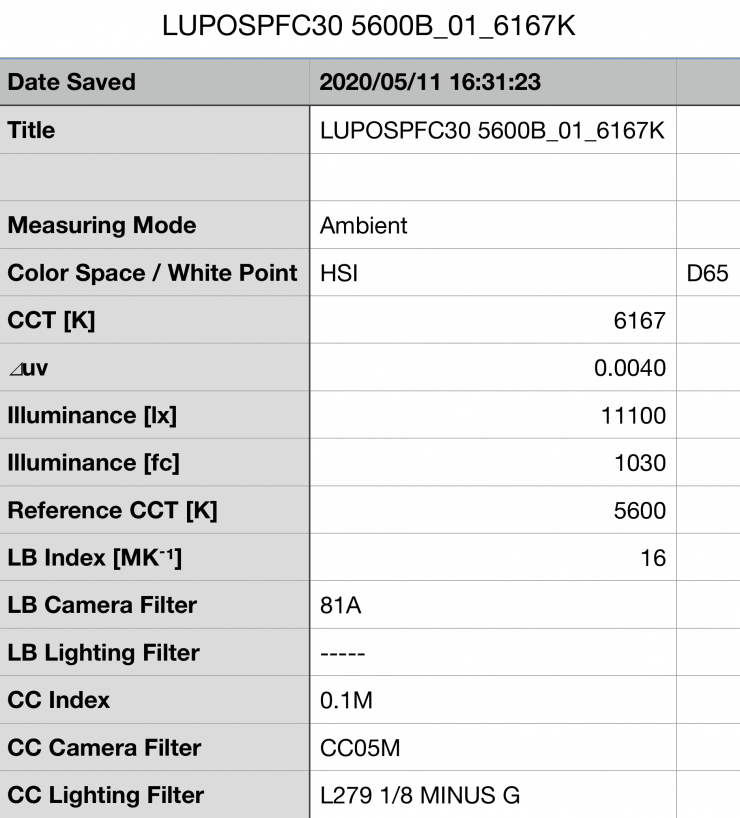
I also wanted to see how much output the light had if you were running it off a camera battery. The light recorded an output of 11100 lx when set at 5600K and running off a camera battery. This was 52% less output than when it is run off mains power.
I wasn’t expecting this much loss in output when using a battery.
3200K
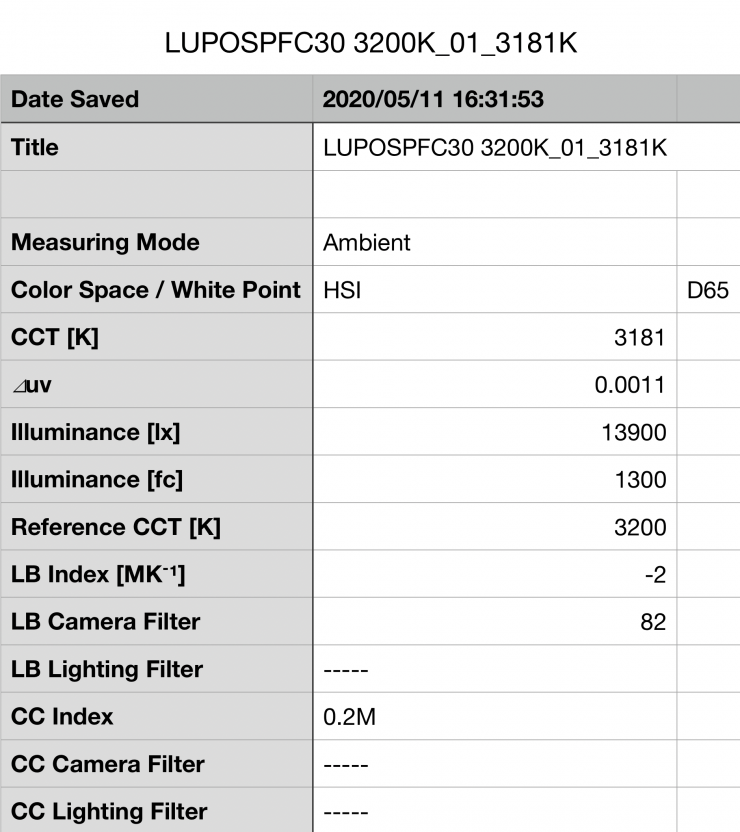
Above you can see the light recorded an output of 13900 lx (1300 fc) when set at 3200K and run off mains power. The output was 21.6% less than when using the light at 5600K.
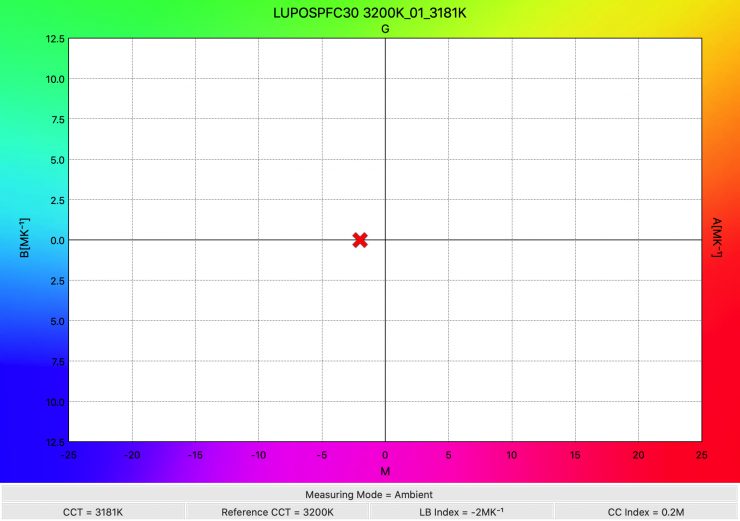
The LUPO produced a Kelvin color temperature of 3181K. This was an excellent reading. The Superpanel had a 0.2M CC Index score. The light is way more Kelvin color-accurate than when used at 5600K.
In terms of output compared to the LUPO Superpanel Dual-Color Soft, it was 70% brighter.
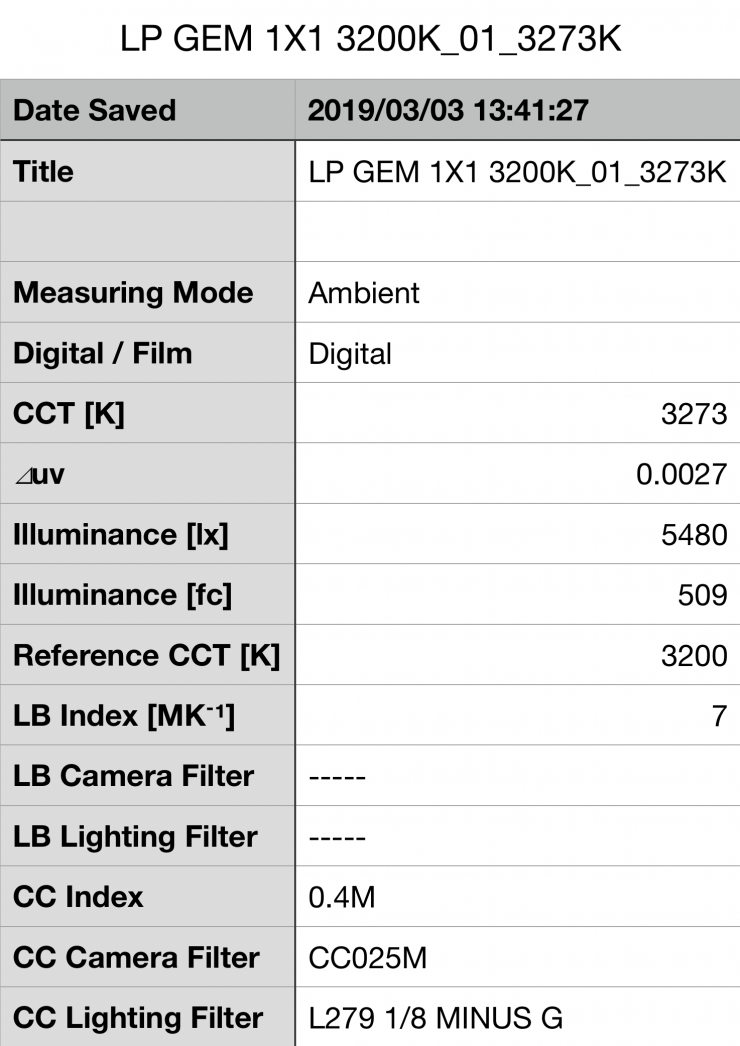
So how does that compare to one of its direct competitors, the Litepanels Gemini 1×1? Above you can see the results from the Litepanels. The Gemini 1×1 has 60.6% less output than the Lupo.
The Kelvin color temperature of the Gemini at 3200K was 3273K, which was just a little bit worse than the 3181K recorded by the Lupo. The Gemini had CC Index score of 0.4M which was slightly worse than the 0.2M of the Lupo.
Here is how the 13900 lx output and 3181K Kelvin color temperature I measured from the Lupo compares to some other RGBWW 1×1 fixtures when used at 3200K.
| Lupo Full Color 30 | Lupo Full Color 30 Soft | Litepanels Gemini 1×1 | ARRI S30-C | Luxli Timpani | |
| Output | 13900 lx | 4150lx | 5480lx | 5530lx | 3480lx |
| Kelvin Color Temperature | 3181K | 3065K | 3273K | 3269K | 3131K |
| CC Index | 0.2M | 0.1M | 0.4M | 0 | 0.2M |
Again, it came as no surprise that compared to its closest competition, the Lupo Full Color 30 has significantly more output when set at 3200K. What surprised me was that it actually recorded the most accurate Kelvin color temperature of any of the lights.
As the Lupo Superpanel Dual Color 30 can produce Kelvin color temperatures from 2800K up to 10,000K, I thought I’d also test the light at its extremes.
Summary of output and Kelvin color temperature results
2800K – 15200 lx (1410 fc) and a Kelvin color temperature reading of 3012K
3200K – 13900 lx (1300 fc) and a Kelvin color temperature reading of 3181K
4500K – 15800 lx (1470 FC) and a Kelvin color temperature reading of 4577K
5600K – 16900 lx (1570 fc) and a Kelvin color temperature reading of 6322K
8000K – 15900 lx (1480 lx) and a Kelvin color temperature reading of 9165K
10,000K– 16400 lx (1520 fc) and a Kelvin color temperature reading of 13068K
These results show me that the lights output remains fairly consistent across its Kelvin color temperature range. The Kelvin color temperate accuracy of the light could be a lot better. The light performs a lot better at 4500K and below. Once you get to 5600K and above the Kelvin color temperature accuracy isn’t nearly as good.
CC Index & ⊿uv
The CC Index displays the CC correction value and whether any magenta or green need to be added or subtracted. 1 CC corresponds to 035 Kodak CC values or 1/8 Rosco filter values. Any reading less than +1.00 or -1.00 and you’re probably not going to need to make any kind of adjustment. The ⊿uv is the value to show how much this light is away from being an ideal light source (black body radiation = incandescent lamp). As with the CC Index you want this number to theoretically be zero. Kelvin is not a linear value, so we need to convert from Kelvin to MK-1 to compare the values of color temperature. To calculate from Kelvin to Mired is MK-1= 1*1000000/Kelvin. While this may sound confusing, it is the only way of measuring if the Kelvin shift is significant enough to warrant having to use a filter for correction. Below are the results for the Lupo:
Kelvin Vs MK-1
| Kelvin | Difference in K | MK-1 | Difference in MK-1 | |
| SET VALUE | 2800K | 0 | 357.14 | 0 |
| ACTUAL READING | 3012K | 232 | 332 | 25.14 MK-1 |
| SET VALUE | 3200K | 0 | 312.5 | 0 |
| ACTUAL READING | 3181K | 29 | 314.37 | -1.87 MK-1 |
| SET VALUE | 4500K | 0 | 222.22 | 0 |
| ACTUAL READING | 4577K | 61 | 218.48 | -3.74 MK-1 |
| SET VALUE | 5600K | 0 | 178.57 | 0 |
| ACTUAL READING | 6322K | 722 | 158.18 | 20.39 MK-1 |
| SET VALUE | 6500K | 0 | 153.85 | 0 |
| ACTUAL READING | 7303K | 803 | 136.93 | 19.92 MK-1 |
| SET VALUE | 8000K | 0 | 125 | 0 |
| ACTUAL READING | 9165K | 1165 | 109.11 | 15.89 MK-1 |
| SET VALUE | 10000K | 0 | 100 | 0 |
| ACTUAL READING | 13068K | 3086 | 75.55 | 24.45 MK-1 |
These figures might look confusing, but what it tells me is that the light is very Kelvin color accurate at 4500K and below, however, once you get over 4500K it goes downhill very quickly. Any MK-1 score that is under -9/9 means you wouldn’t have to use any color correction gels. With this light at 5600K and above you would need to correct the light by either making adjustments to the Kelvin color temperature on the light itself, or use color correction gels.
CC INDEX & ⊿uv
| CC INDEX | ⊿uv | |
| 2800K | 0.3M | 0.0024 |
| 3200K | 0.2M | -0.0011 |
| 4500K | 0.1G | -0.0019 |
| 5600K | 0.0 | 0.0017 |
| 6500K | 0.3G | -0.0015 |
| 8000K | 0.4G | -0.0033 |
| 10000K | 0.9G | -0.0002 |
HSI Output
The problem I have found with most RGBWW lights is that the output when using them to create colors is significantly lower than that when they are used in their CCI modes. So as the Lupo has such a high output, is the output when creating colors also better?
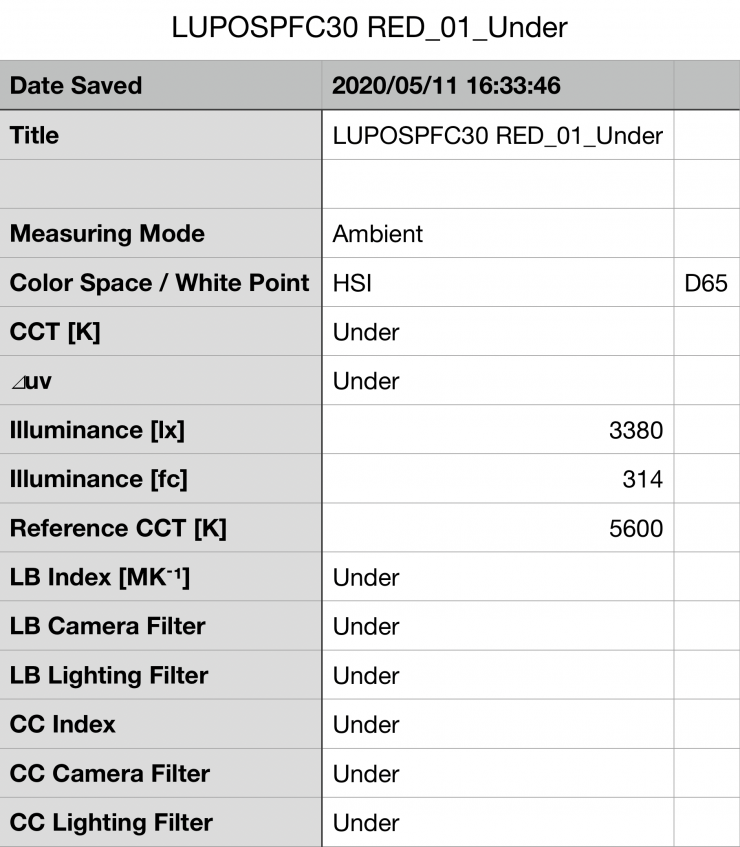
Above I replicated a 100% saturated RED, and as you can see the output was just 3380 lx (314 FC). In saying that, this is a lot more output that most other 1×1 RGBWW lights are capable of producing when they are set to a saturated color.
Color Rendering
So now that we have seen how much output the LUPO Superpanels Full Color 30 produces, how does it perform when it comes to replicating accurate colors? Well, let’s find out.
5600K
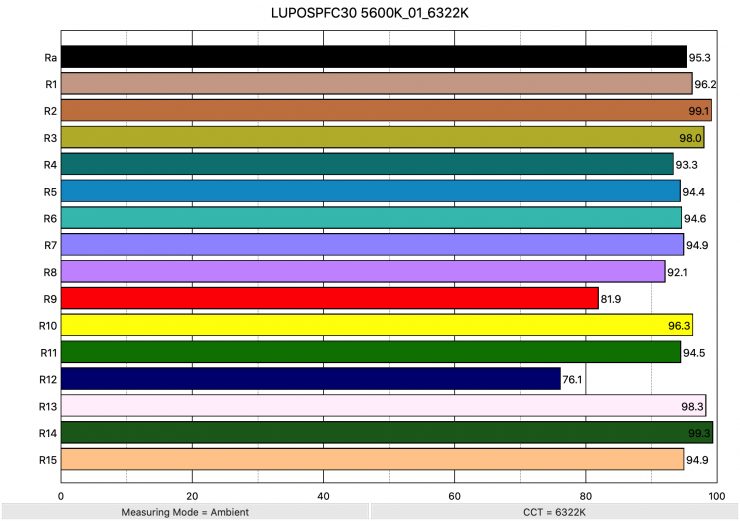
Above you can see that when the light was set at 5600K it recorded an average CRI (R1-R8) of 95.3 and an extended CRI (R1-R15) of 93.59. For replicating accurate skin tones it recorded 81.9 for R9 (red), 98.3 for R13 (closest to caucasian skin tones), and 94.9 for R15 (closest to Asian skin tones).
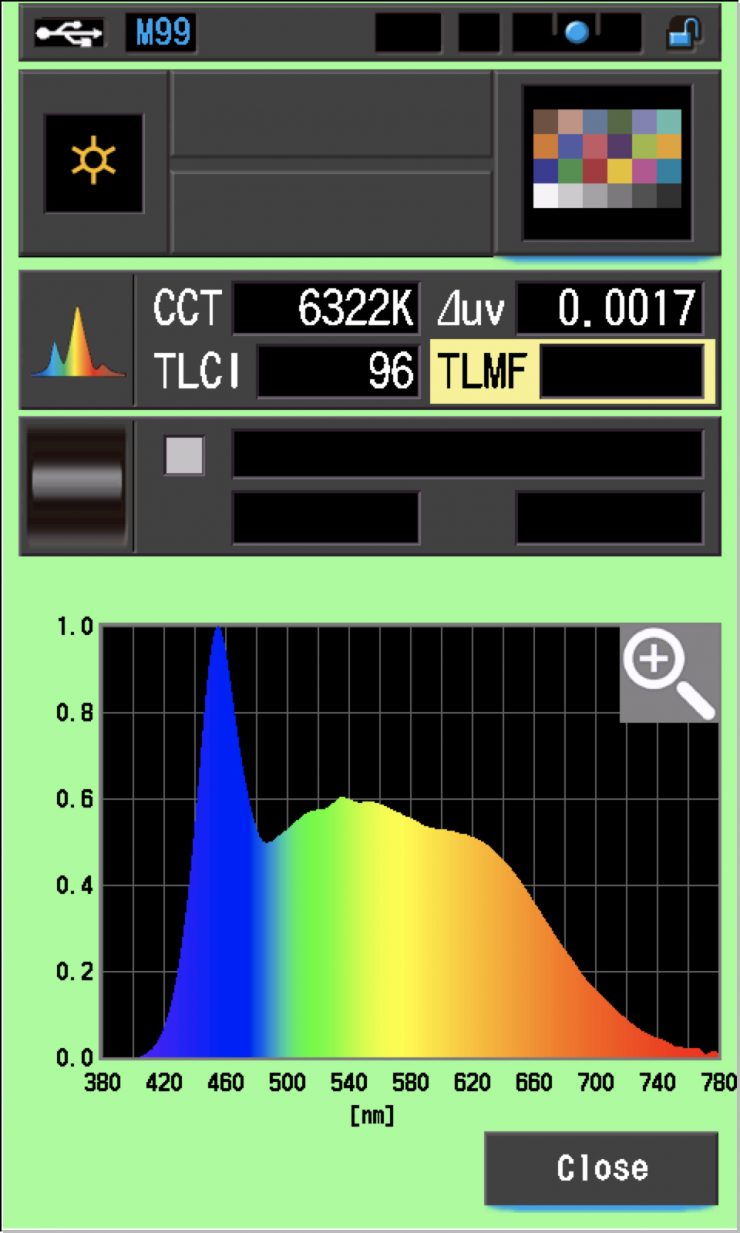
The light had a TLCI score at 5600K of 96.
How does this compare to the Superpanel Full Color 30 Soft? The Superpanel Full Color 30 Soft recorded an extended CRI (R1-R15) of 93.40. So the Full Color 30 version actually has slightly better color rendering (well it’s almost the same) which is good to see. It’s nice that LUPO has been able to make an RGBWW light without sacrificing the color accuracy.
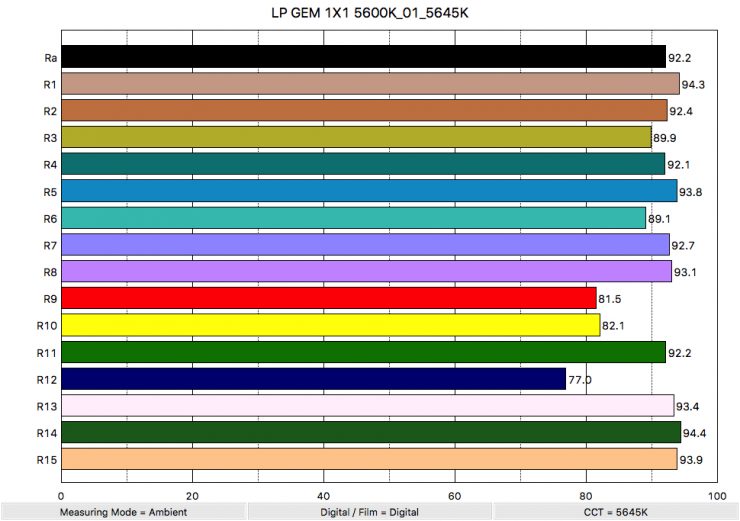
So how does that compare to one of its direct competitors, the Litepanels Gemini 1×1? Above you can see the results from the Litepanels. The Gemini recorded an average CRI (R1-R8) of 92.2 and an extended CRI (R1-R15) of 93.32. For replicating accurate skin tones it recorded 81.5 for R9 (red), 93.4 for R13 (closest to caucasian skin tones), and 93.9 for R15 (closest to Asian skin tones).
How do all of the Lupo’s color rendering results compare to the competition, including Lupo’s Superpanel Full Color 30 Soft? Below you can see a comparison:
| Lupo Full Color 30 | Lupo Full Color 30 Soft | Litepanels Gemini 1×1 | ARRI S30-C | Luxli Timpani | |
| Extended CRI | 93.59 | 93.4 | 91.32 | 93.39 | 96.2 |
| R9 | 81.9 | 86.2 | 81.5 | 89.7 | 97.9 |
| R13 | 98.3 | 97.3 | 93.4 | 95.5 | 99.6 |
| R15 | 94.9 | 94.4 | 93.9 | 97.0 | 97.0 |
The Lupo Full Color 30 actually recorded good scores, and its extended CRI result was only trailing the Luxli Timpani.
Now, as I can adjust the lights Kelvin color temperature and add or subtract green, I wanted to see if I could get even better results.
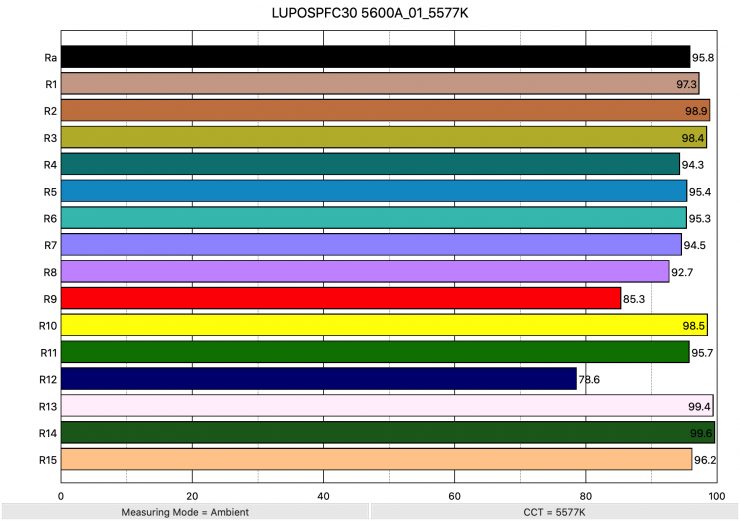
Above you can see that by setting the Kelvin color temperature on the light to 5150K and dialing in +0.09 Green I could obtain an average CRI of 95.8 and an Extended CRI of 94.67. The scores for R9, R13, and R15 all improved.
3200K
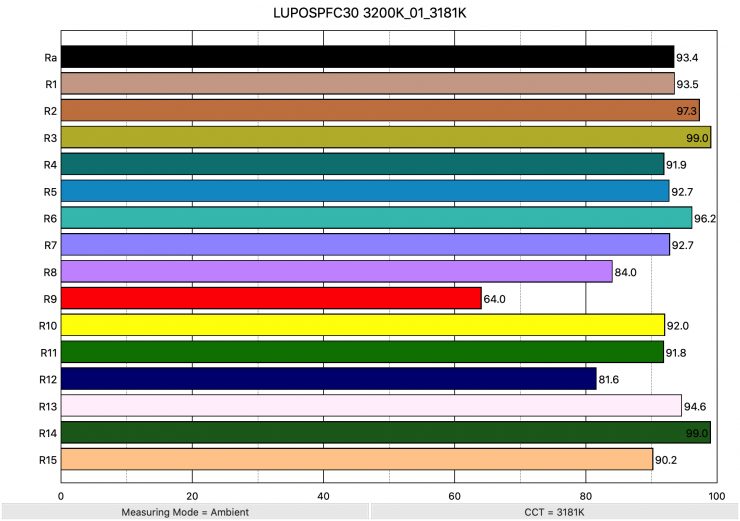
Above you can see the scores for when the light was used at 3200K. It recorded an average CRI (R1-R8) of 93.4 and an extended CRI (R1-R15) of 90.7. For replicating accurate skin tones it recorded 64 for R9 (red), 94.6 for R13 (closest to caucasian skin tones), and 90.2 for R15 (closest to Asian skin tones). These results were not as good as those of the LUPO Superpanels Full Color 30 Soft.
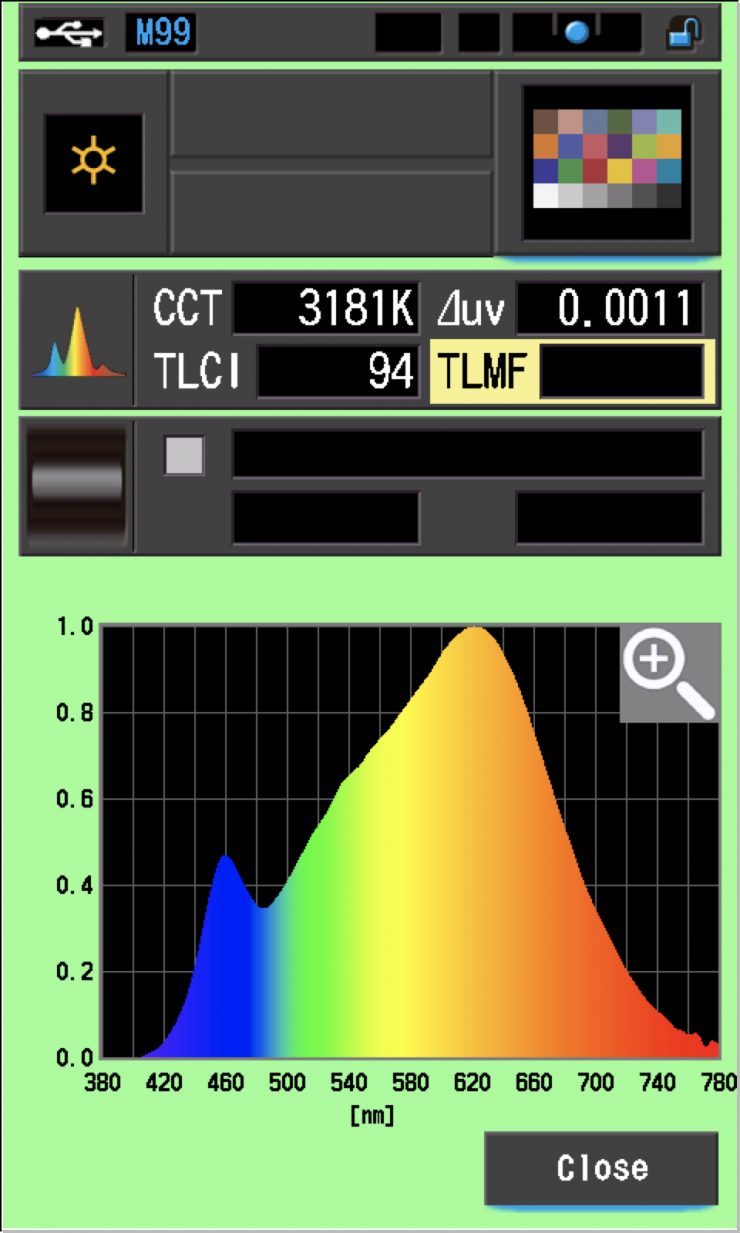
At 3200K the light had a TLCI score of 94.
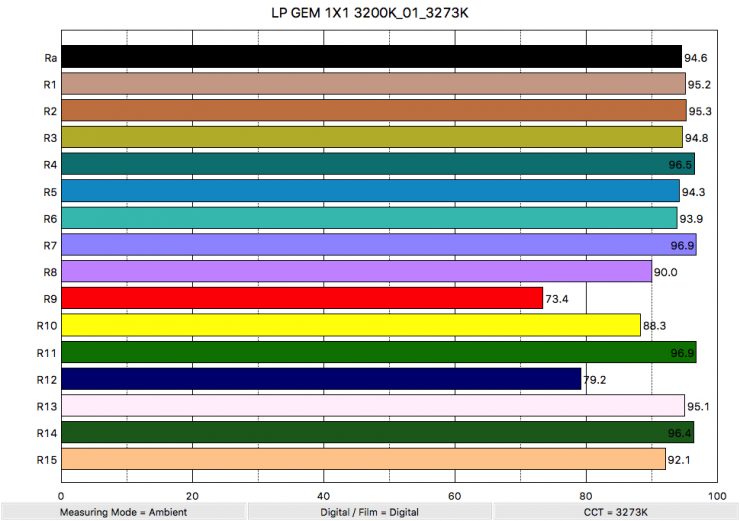
So how does that compare to one of its direct competitors, the Litepanels Gemini 1×1? Above you can see the results from the Litepanels. The Gemini recorded an average CRI (R1-R8) of 94.6 and an extended CRI (R1-R15) of 95.45. For replicating accurate skin tones it recorded 73.4 for R9 (red), 95.1 for R13 (closest to caucasian skin tones), and 92.1 for R15 (closest to Asian skin tones).
How do all of the Lupo’s color rendering results compare to the competition, including Lupo’s Superpanel Full Color 30 Soft? Below you can see a comparison:
| Lupo Full Color 30 | Lupo Full Color 30 Soft | Litepanels Gemini 1×1 | ARRI S30-C | Luxli Timpani | |
| Extended CRI | 90.7 | 91.86 | 93.22 | 93.56 | 95.45 |
| R9 | 64 | 76.3 | 77.2 | 80.2 | 92.6 |
| R13 | 94.6 | 95.1 | 96.6 | 97.7 | 96.1 |
| R15 | 90.2 | 93.4 | 93.7 | 97.5 | 96.3 |
The Lupo Full Color 30 had the worst scores of all of the lights when used at 3200K. Its inability to produce the color red will affect the light’s ability to replicate nice caucasian skin tones.
Spectral distribution
Let’s now look at the lights spectral distribution.
5600K
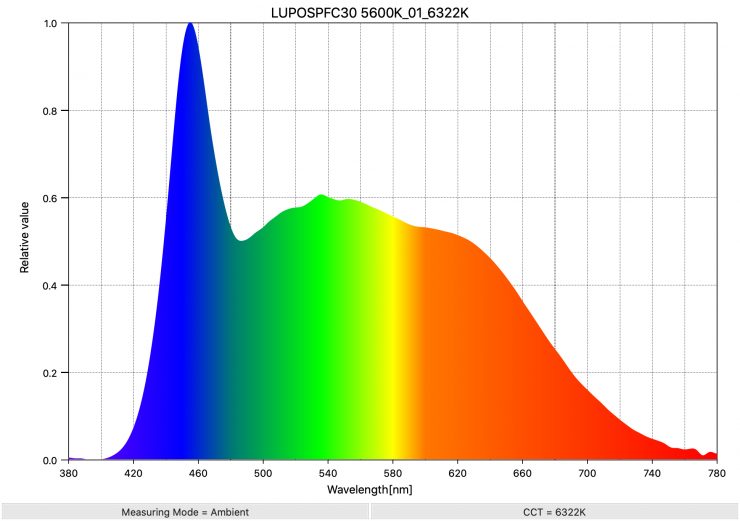
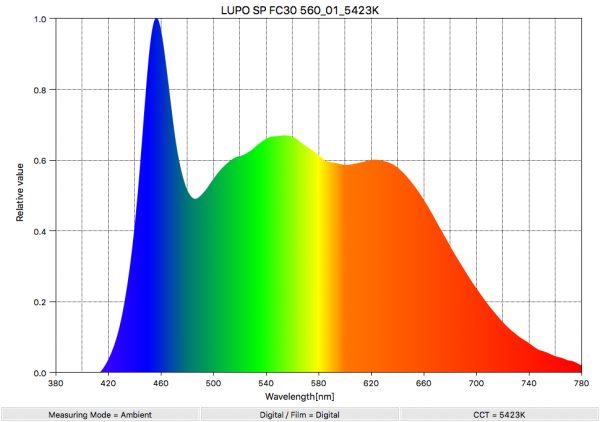
Spectral distribution of the Full Color 30 Soft when it is set at 5600K.
Above you can see the spectral distribution of the Lupo when it is set at 5600K. The spectral distribution is pretty good at 5600K. Interestingly enough you can see that the Full Color 30 has a fuller color spectrum. This spectral distribution is fairly common for a lot of LED lights at 5600K.
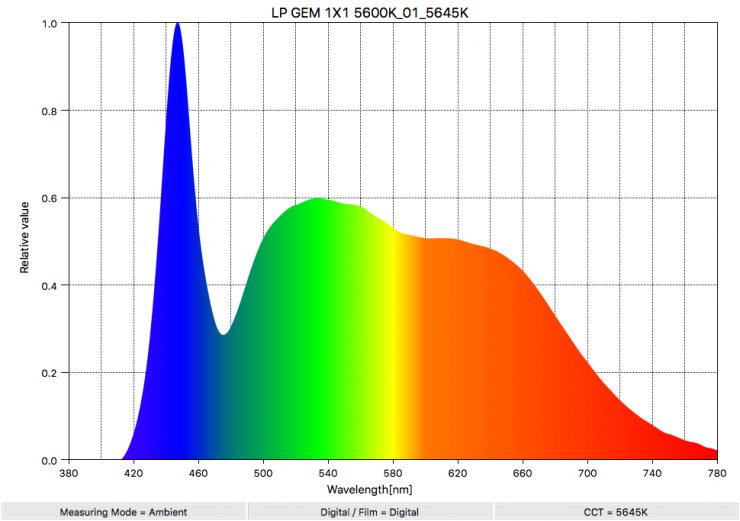
Above you can see the spectral distribution of the Litepanels Gemini 1×1 when set at 5600K.
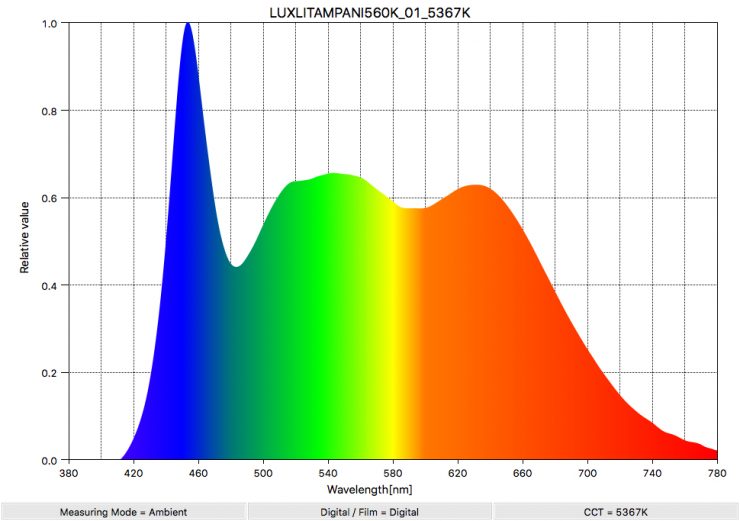
Luxli Timpani 1×1 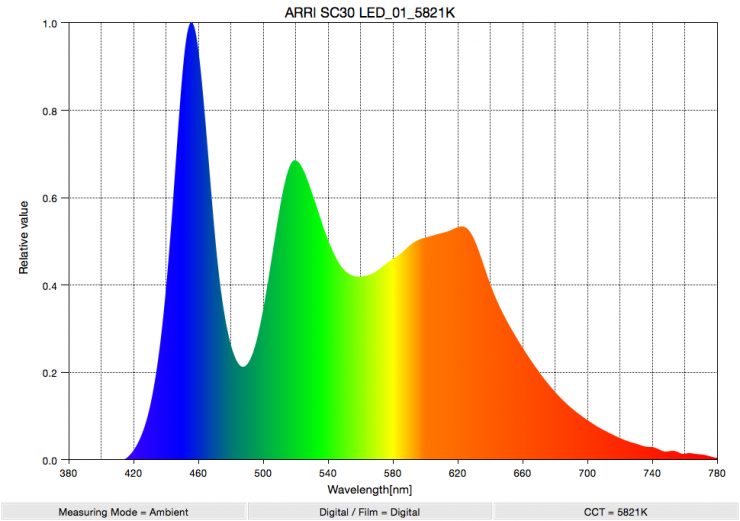
ARRI S30-C
Above you can see the spectral distributions for the ARRI S30-C and Luxli Timpani.
The overall spectral distribution of the Litepanels and the Lupo Superpanel Full Color 30 are almost identical.
3200K
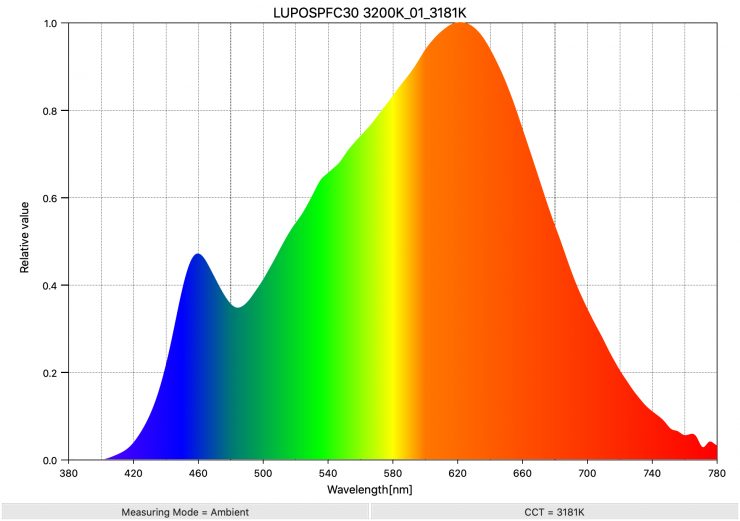
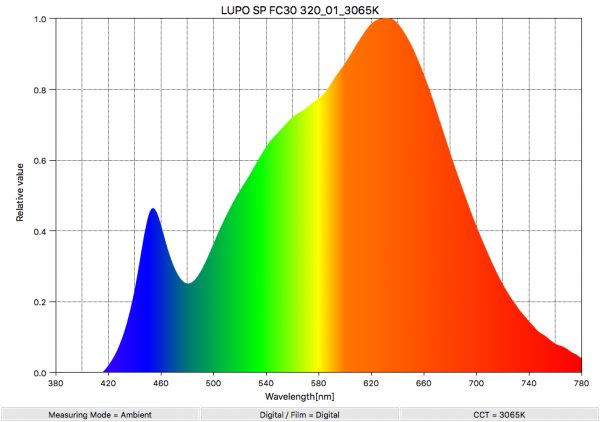
Spectral distribution of the Full Color 30 Soft when it is set at 3200K.
Above you can see the spectral distribution of the LUPO when it is set at 3200K. The spectral distribution is excellent at 3200K and the light doesn’t have any large green spikes. This spectral distribution is very good for a LED light at 3200K.
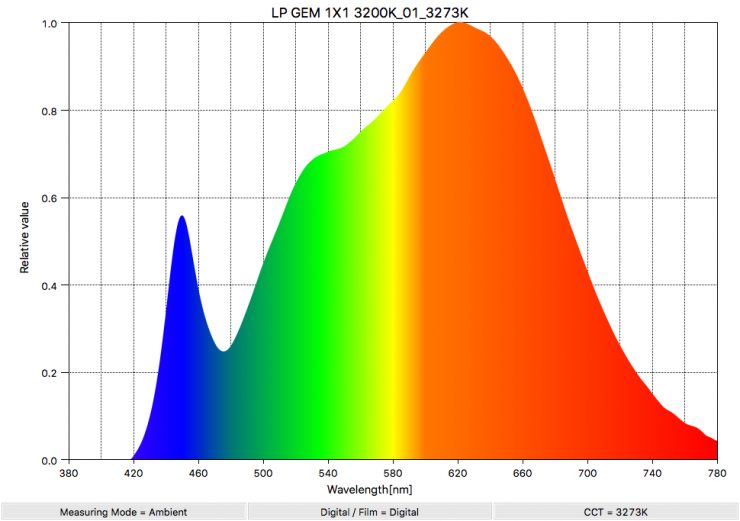
Above you can see the spectral distribution of the Litepanels Gemini 1×1 when set at 3200K.
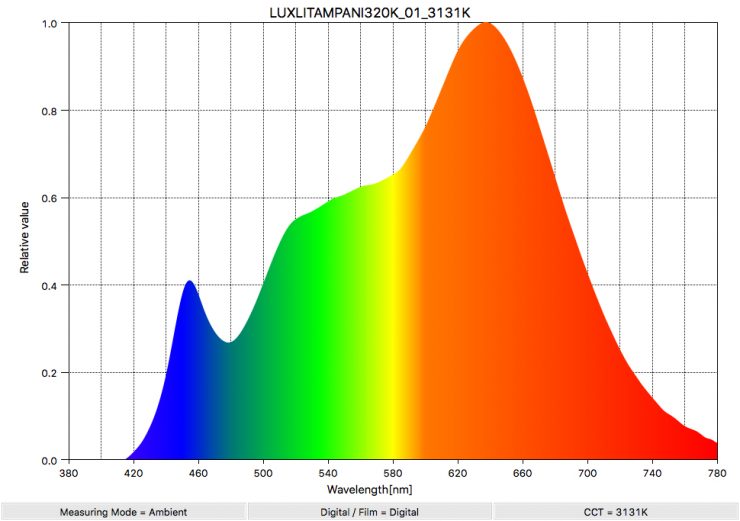
Luxli Timpani 1×1 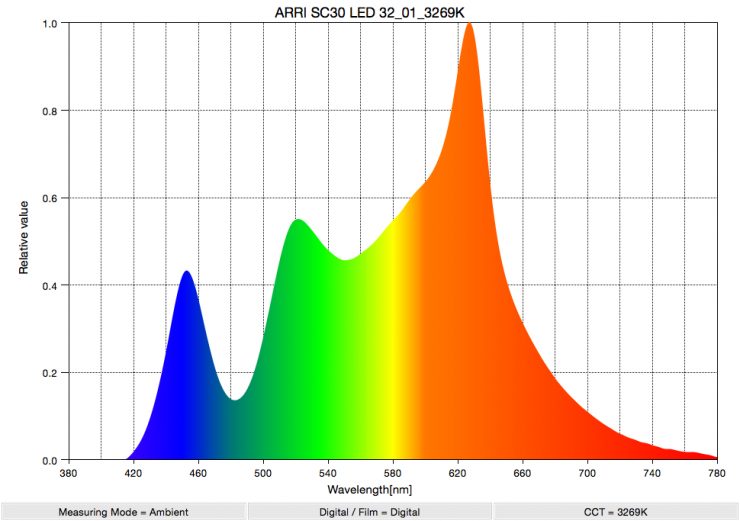
ARRI S30-C
Above you can see the spectral distributions for the ARRI S30-C and Luxli Timpani.
The spectral distribution of the Lupo at 3200K is excellent and is a little bit more linear than the other lights
SSI
SSI (Spectral Similarity Index) was developed by the Sci-Tech Council of the Academy. SSI gives me the ability to set any light as a standard, or use predefined standards (such as CIE D55), and then give other lights an SSI score based upon how well they will match standards such as CIE D55 measure spectral response and compare it directly against an ideal light source.
3200K
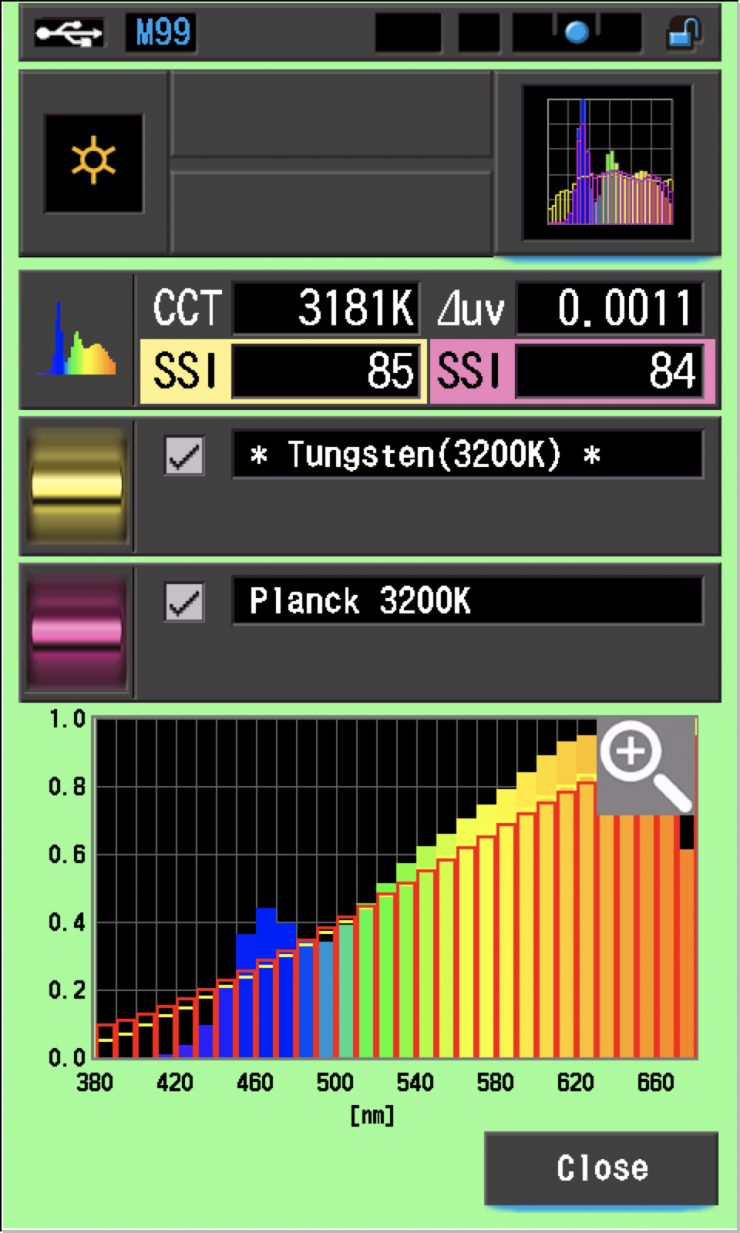
In this graph the Gold bars indicate a perfect 3200 (Tungsten source. The Red bars indicate a Planck 3200K source. This lets us compare how close to a perfect 3200k lighting source the Lupo is. A score in the low to mid-80s is very good for a 3200K LED light.
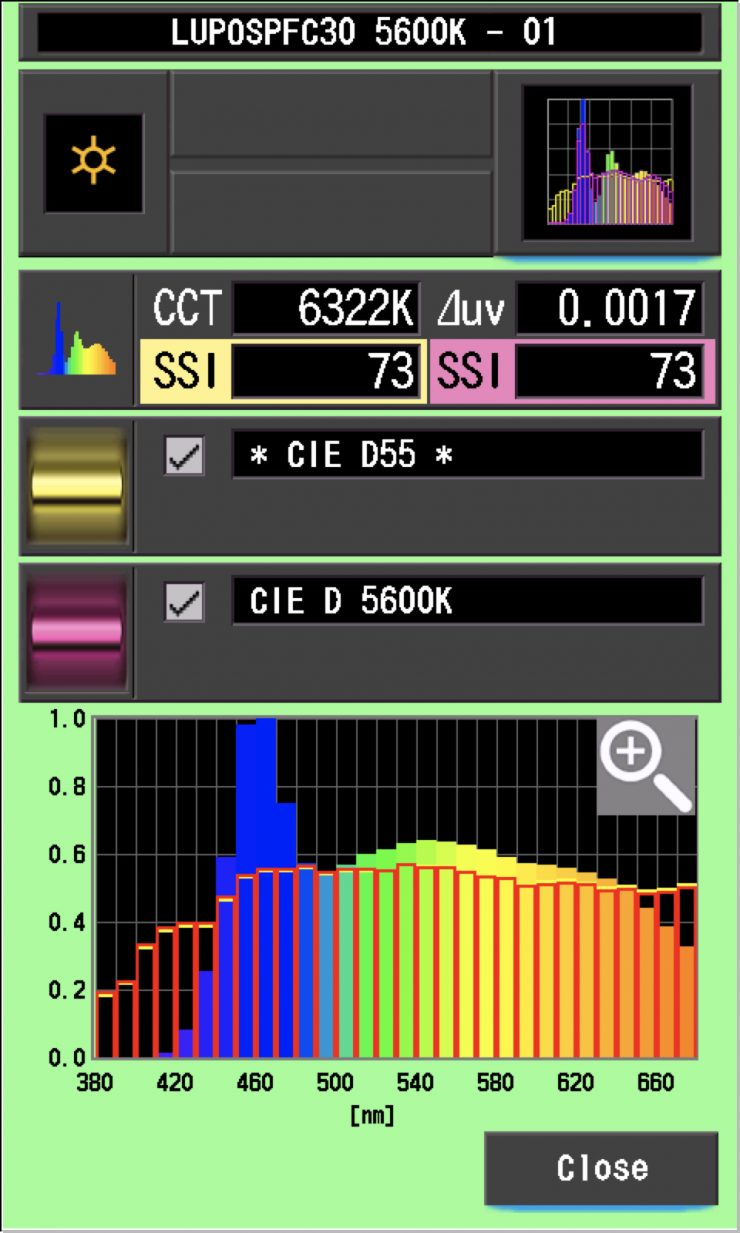
In this graph above the gold bars indicate a perfect D55 source. The Red bars indicate a 5600K source. This lets us compare how close to a perfect 5600k lighting source the Lupo is. A score in the low 70’s is very common for most 5600K LED sources.
The main reason we want to record SSI scores is so we can see how well they match with other lights. I was curious to see how well the Full Color 30 matched the Lupo Actionpanel Dual Color Full Color 30 Soft at 5600K. As you can see the Full Color 30 was a better match to the Actionpanel Dual Color than the Full Color 30 Soft.
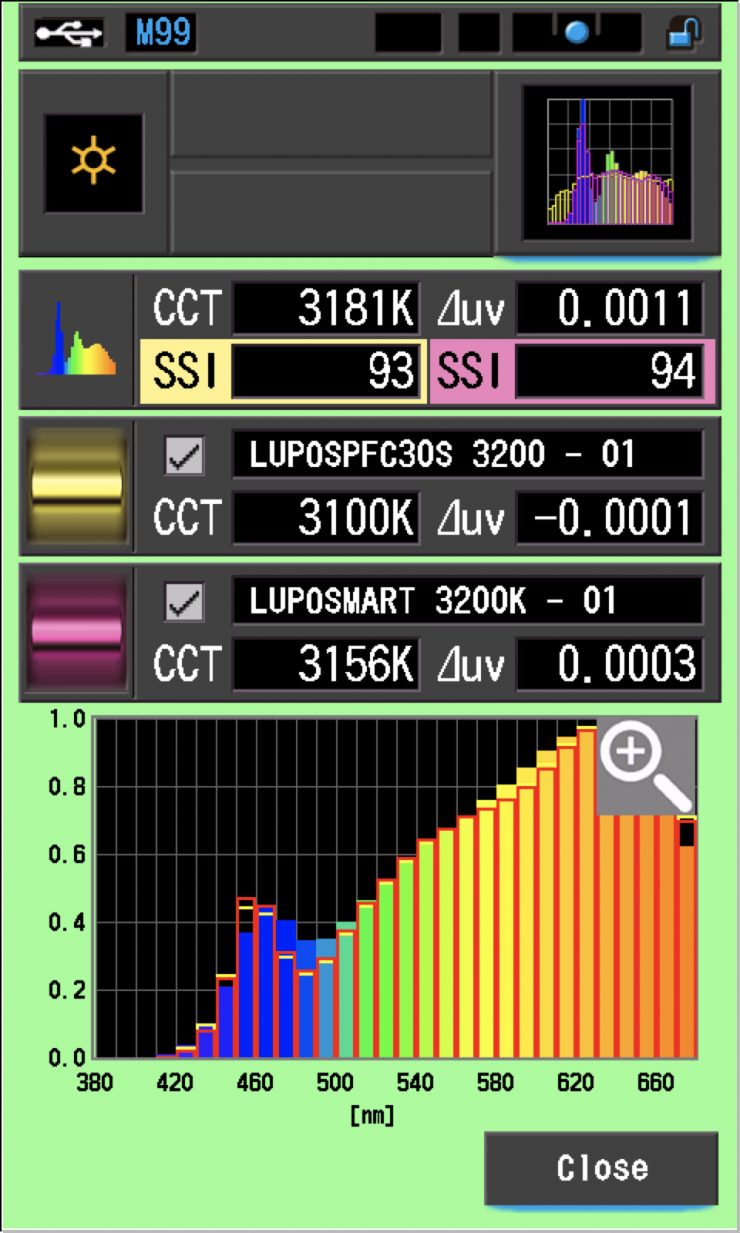
I was also curious to see how the Lupo Superpanel Full Color 30 matched the Lupo Full Color 30 Soft and the small Lupo Smartpanel at 3200K. The Full Color 30, while not an exact match, would work pretty well with the other two Lupo lights.
Real world performance & quality of light
As I always say, photometric scores only tell you part of the story. So do the scores from the LUPO Superpanel Full Color 30 translate into real-world performance?
Starting with a powerful source and heavily diffusing it, is usually a good way of producing a nice soft source. If you don’t have a high enough output to begin with, and then attempt to heavily diffuse that lighting source, often the brightness of that light is reduced to a point where it’s only usable when placed very close to a subject. This is the main advantage the Lupo Superpanel Full Color 30 has over a lot of other RGBWW 1×1 lights.
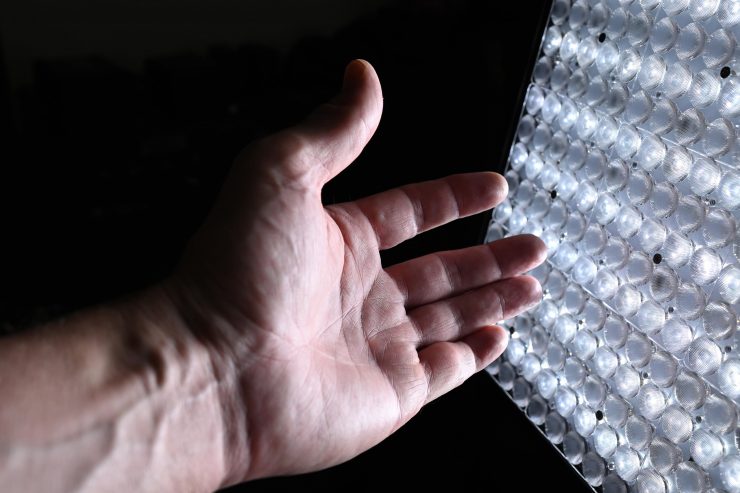
Lupo Superpanel Full Color 30 
Lupo Superpanel Full Color 30
The light without any diffusion is quite harsh as you can see from the comparison above between the Full Color 30 and Full Color 30 Soft.
The LUPO’s high output for a 1×1 RGBWW light sets it apart from other fixtures in this space. This makes the light ideal for solo operators who need a light that is quick to set up for interviews if you combine it with a softbox or punch it through diffusion.
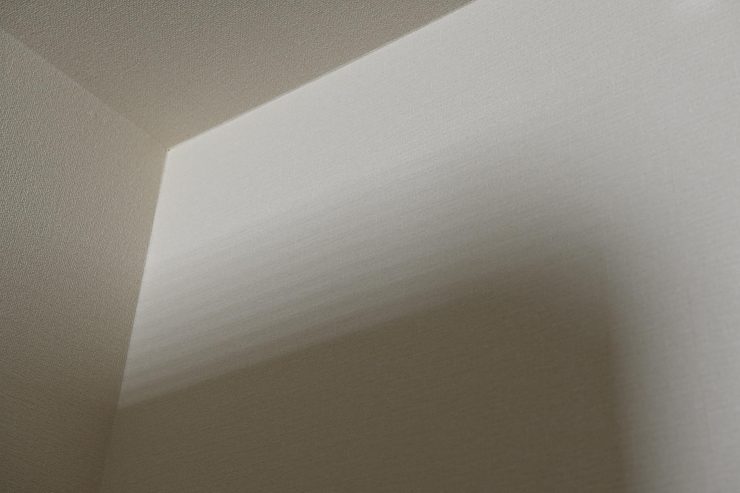
Shadows on a wall 5 meters away from the light 
The trouble with lights that don’t feature in-built diffusion is that you will get bad hatched shadows.
The light is bright enough that it can be used for lighting up some rooms by indirectly bouncing it into a wall or ceiling if you just need some additional fill and don’t want the light to look forced. It’s also an ideal light for news crews doing live crosses as the fixture can be run off a camera battery and it’s powerful enough to provide a nice amount of light even in really bright conditions. You do need to be aware, however, that the light draws 200W so you need to have a high capacity battery to use this light remotely in the field.
Having the ability to control green and magenta is huge, and this is perhaps the feature I like the most about this light. Being able to match other fixtures as well as getting rid of any green or magenta that you may see when using the light is something you shouldn’t take for granted.
As far as the RGBW, HSI, and effects modes go, while they are great to have available I don’t tend to use those features that much in my line of work. In saying that, being able to generate different colors is handy for lighting up backdrops or creating color separation during interviews.
How does it compare to the competition?
I don’t have access to all of the lights I have been comparing the Lupo to, but I can compare it head-to-head against the Litepanels Gemini Soft, Lupo Superpanel Soft Full Color 30, and Luxli Timpani.
Head-to-head comparisons are hard to do because different cameras have different sensors and the color response is different from camera to camera. One light may look better with a certain camera than another.
I am going to just do a couple of head-to-head examples looking at the following:
- Color Reproduction– how accurate are the lights at 3200K and 5600K when no WB is done and when a camera WB is done.
- Skin Tones- how do the lights look at 3200K and 5600K when no WB is done and when a camera WB is done.
Color Reproduction
So, let’s compare the color rendition of all of the lights when used at 3200K and 5600K when a preset WB is used in camera and when a WB has been done.
For these tests, I have kept the exposure, ISO, and shutter speed the same. I used a 3200K and 5600K preset WB and then WB balanced the camera using an 18% grey card.
3200K (Preset WB)
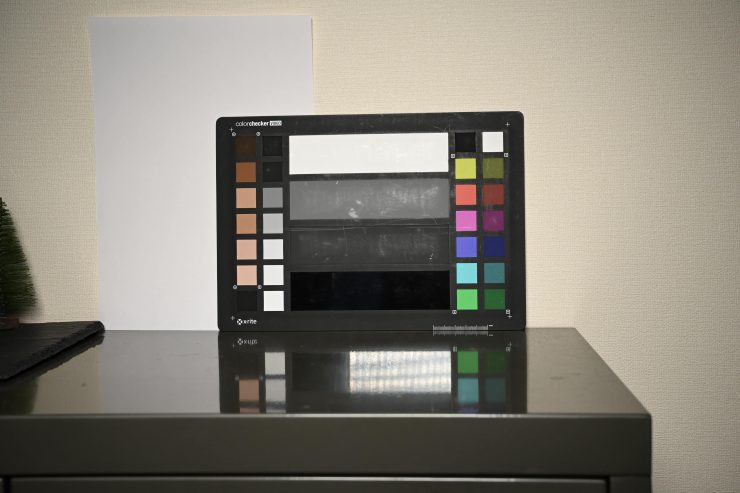
Lupo Superpanel Full Color 30 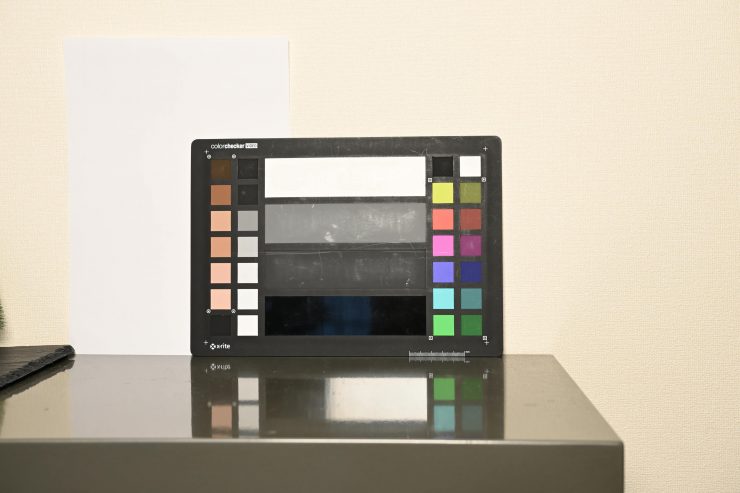
Lupo Superpanel Soft Full Color 30 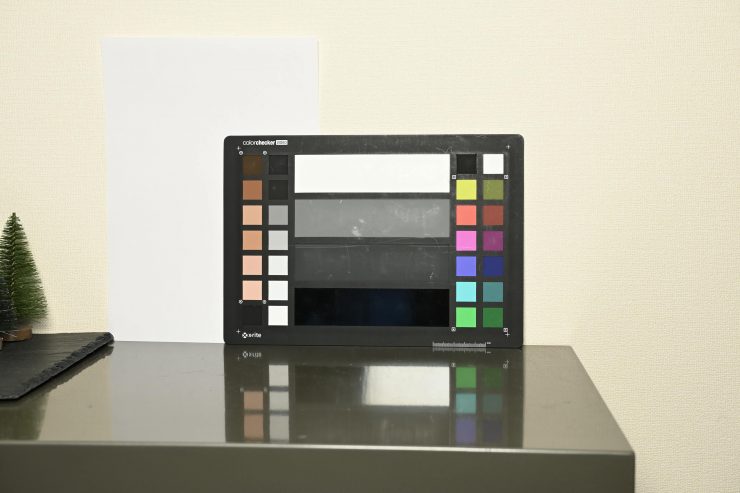
Litepanels Gemini Soft 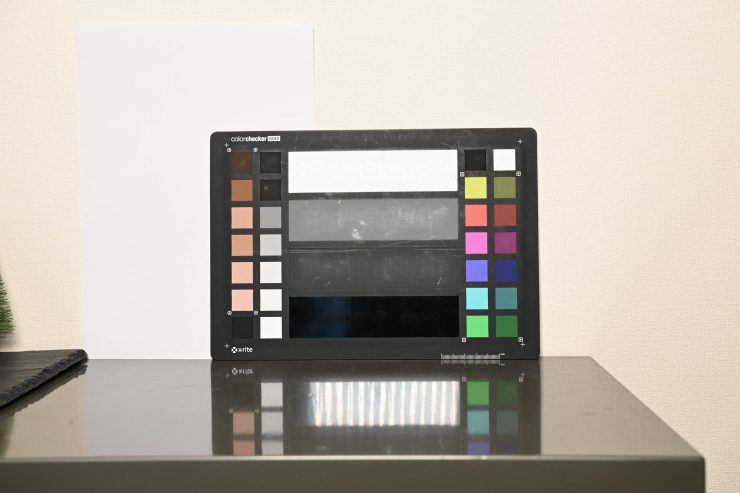
The two Lupo lights are quite neutral at a 3200K preset white balance, with the Full Color 30 just ahead of the Soft Full Color 30. The Litepanels Gemini soft has a tiny push towards green, and the Luxli perhaps a very slight magenta push.
3200K (WB Done)
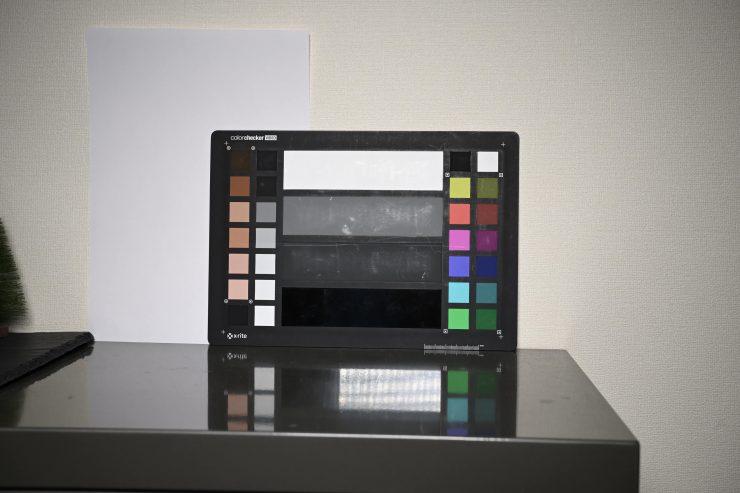
Lupo Superpanel Full Color 30 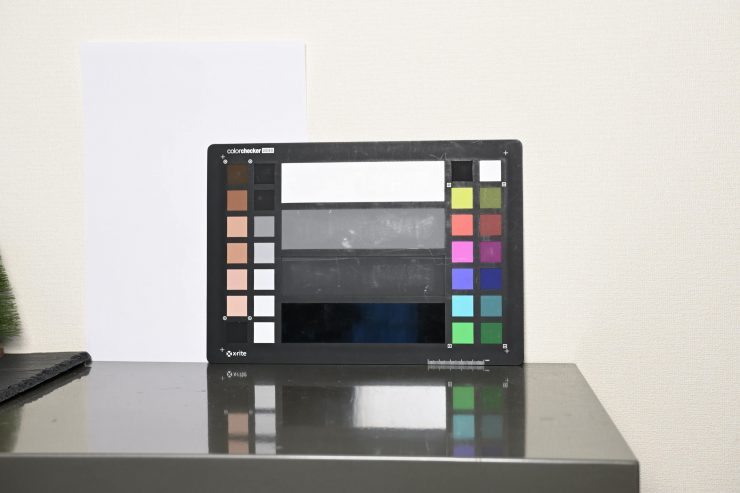
Lupo Superpanel Soft Full Color 30 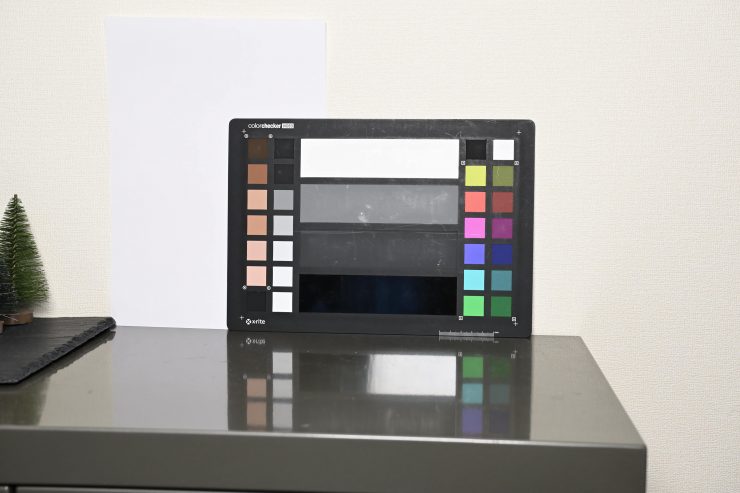
Litepanels Gemini Soft 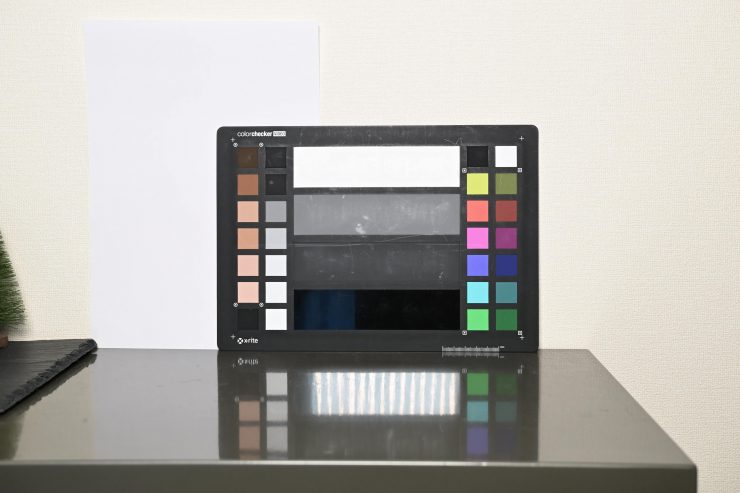
Luxli Timpani
As you can see, all the lights are pretty neutral once a WB has been done. You would struggle to see any real-world difference between these lights if you do a WB.
5600K (Preset WB)
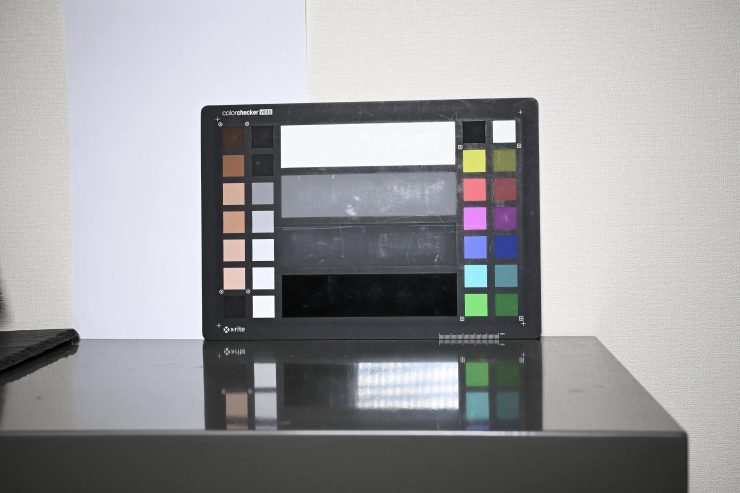
Lupo Superpanel Full Color 30 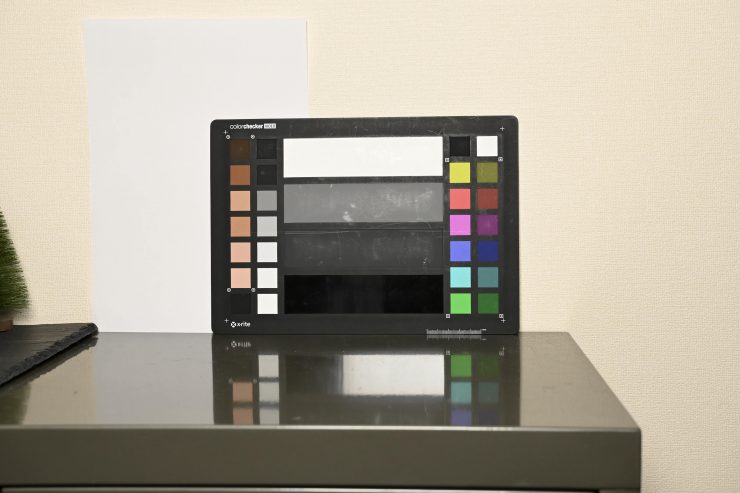
Lupo Superpanel Soft Full Color 30 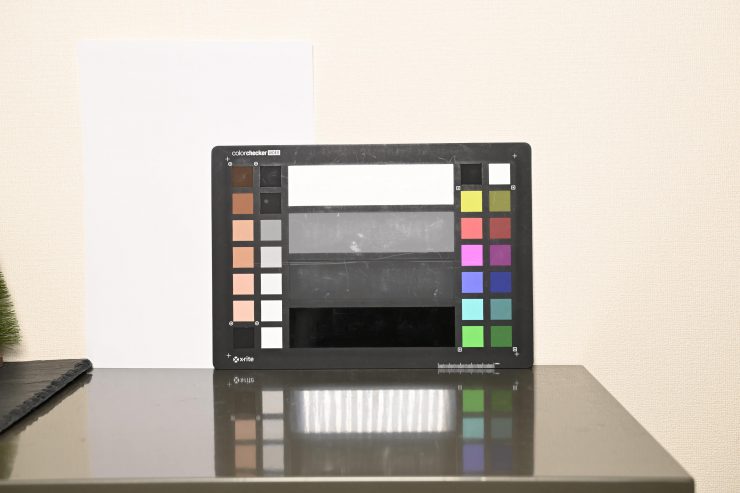
Luxli Timpani
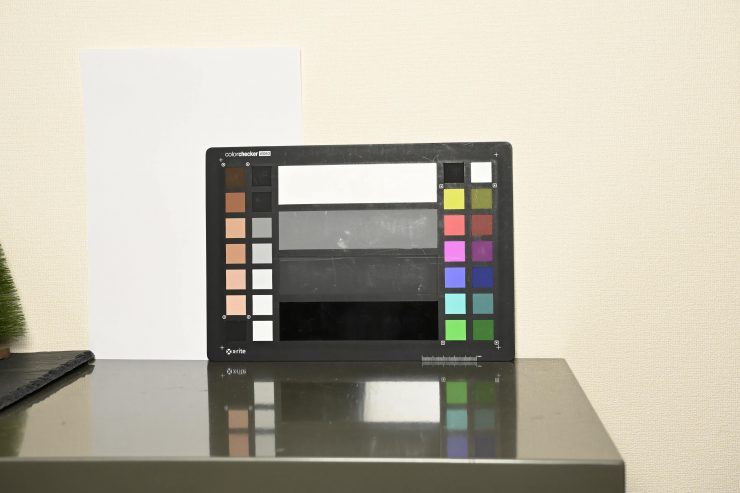
The Luxli has a slight skew towards magenta, while the Litepanels Gemini Soft and Lupo Superpanel Soft Full Color 30 lean slightly towards green. The Lupo Superpanel Full Color 30 is probably the most neutral, but that doesn’ mean it will produce good skin tones as we will see in one of the other tests.
5600K (WB Done)
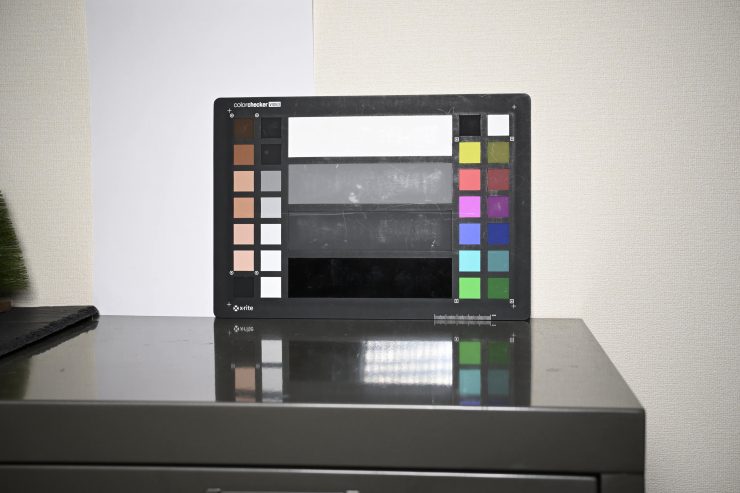
Lupo Superpanel Full Color 30 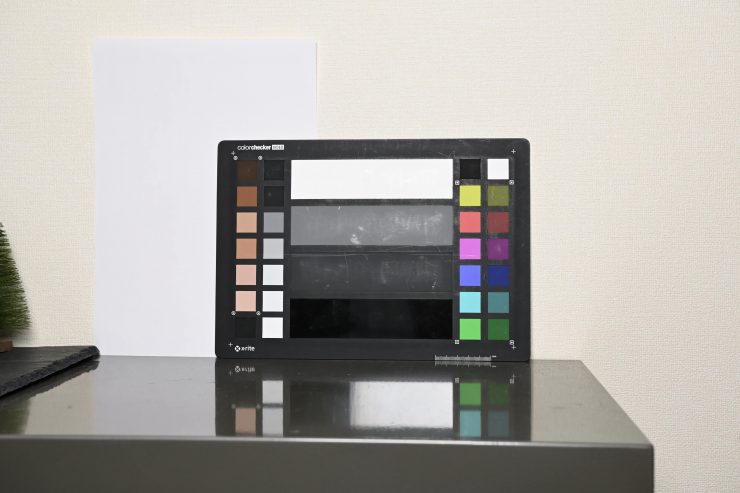
Lupo Superpanel Soft Full Color 30 
Luxli Timpani 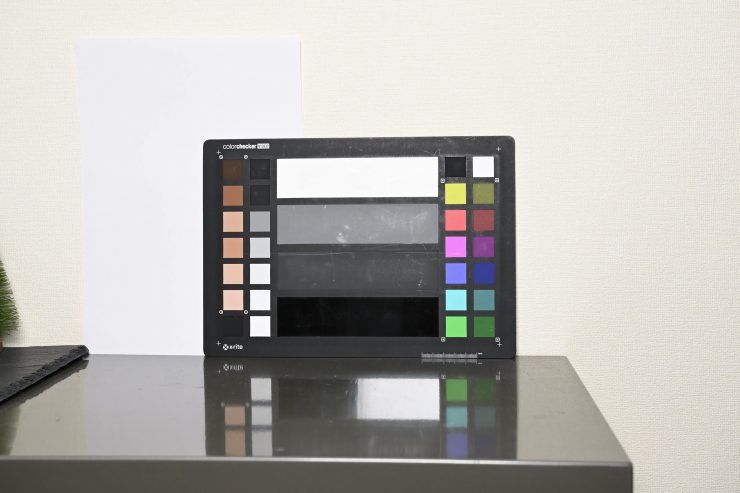
Litepanels Gemini Soft
As you can see, all of the lights correct up nicely once a WB is done. The Luxli seems to have a slight advantage over the other lights, but it is still very close.
Skin Tones
Replicating good skin tones is an important factor you need to consider when using any light. Skin tones can look very different when different cameras/sensors are used. Lights can also look better with certain cameras/sensors as well, so doing head-to-head tests is difficult unless you are testing different camera and different light combinations.
For these tests, I have kept the exposure, ISO, and shutter speed the same. I used a 3200K and 5600K preset WB and then WB balanced the camera using an 18% grey card. Nothing has been altered or changed in post.
Again, I need to stress that skin tones can obviously be manipulated in post. This is simply to show how the various lights look on skin tones without any corrections being done.
So you may well ask, ‘Why bother doing this test then?’ This is still a good way of seeing the differences between all of the lights and how they vary.
Please don’t pay any attention to the exposure of the various lights. The same ISO and F stop were kept for all shots. All of the lights have different strengths of in-built diffusion and different beam angles.
No correction has been done in post. This is exactly as was shot. It is important to remember that all of these lights have +/- correction so they can all be fine-tuned to produce better results.
Sorry, you have to look at my ugly mug for these next tests! Unfortunately, I had to shoot myself.
3200K (Preset WB)
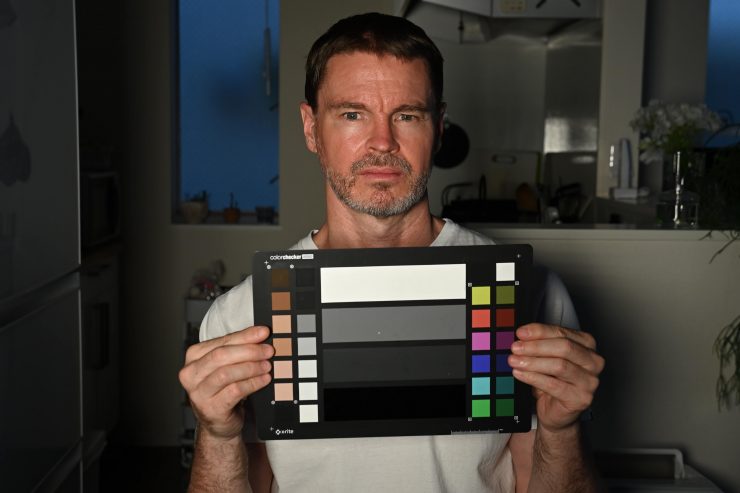
Lupo Superpanel Dual Color 30 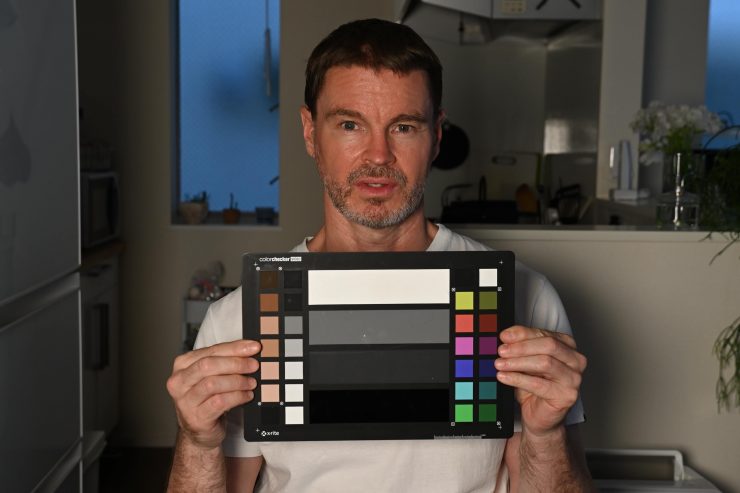
Lupo Superpanel Soft Full Color 30 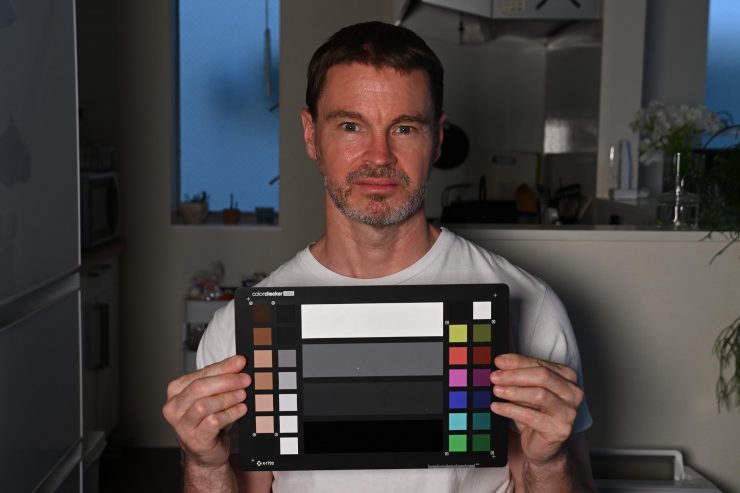
Luxli Timpani 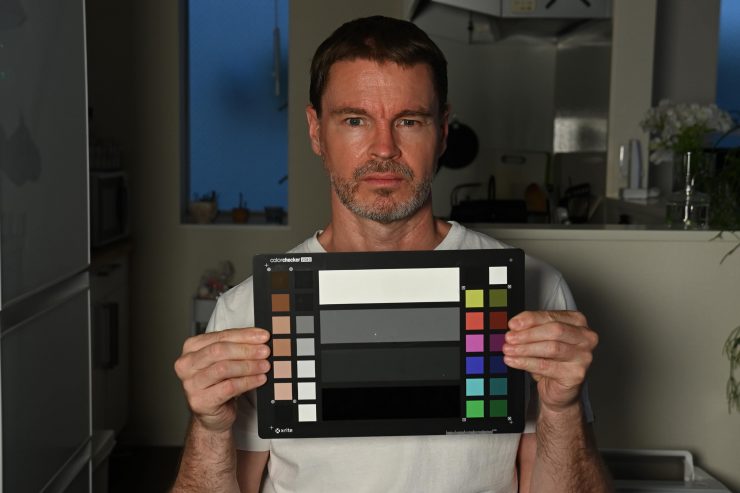
Litepanels Gemini Soft
At a preset 3200K WB you can see that the Luxli Timpani has the most accurate color reproduction. The Luxli is very good at reproducing the color red and you can clearly see that with the skin tones. The Litepanels Gemini Soft, and the two Lupo lights have green casts if you look at the skin and the white. The Lupo Superpanel Full Color 30 has probably the worst colors amongst these lights. This is no surprise given the Kelvin color temperature it produced during testing.
3200K (WB done)
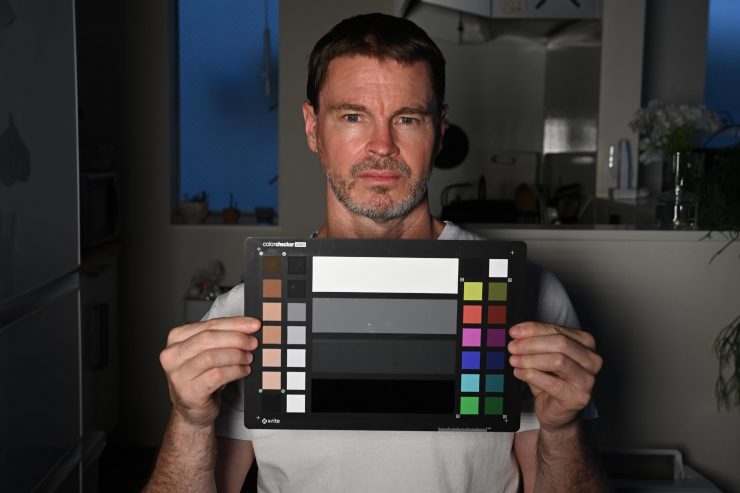
Lupo Superpanel Dual Color 30 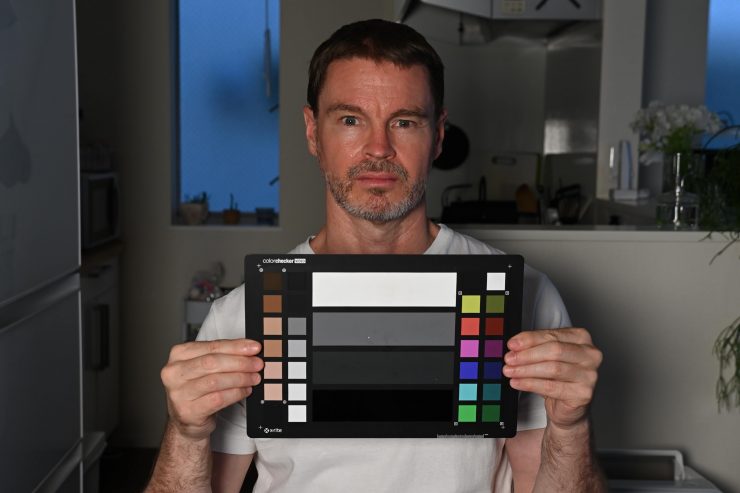
Lupo Superpanel Soft Full Color 30 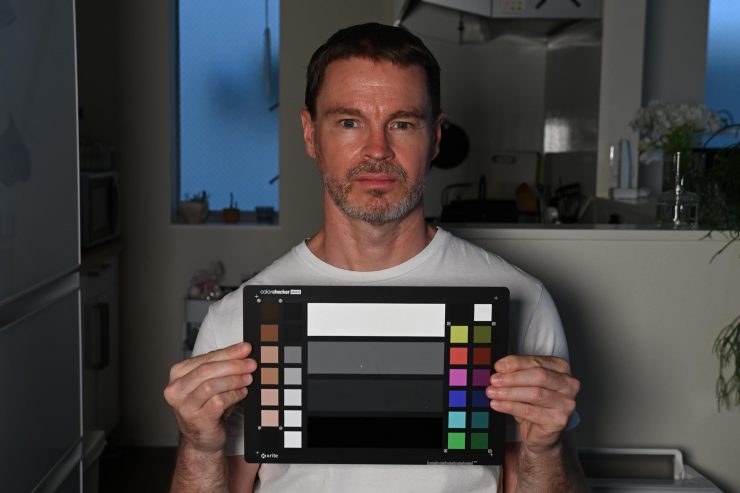
Luxli Timpani 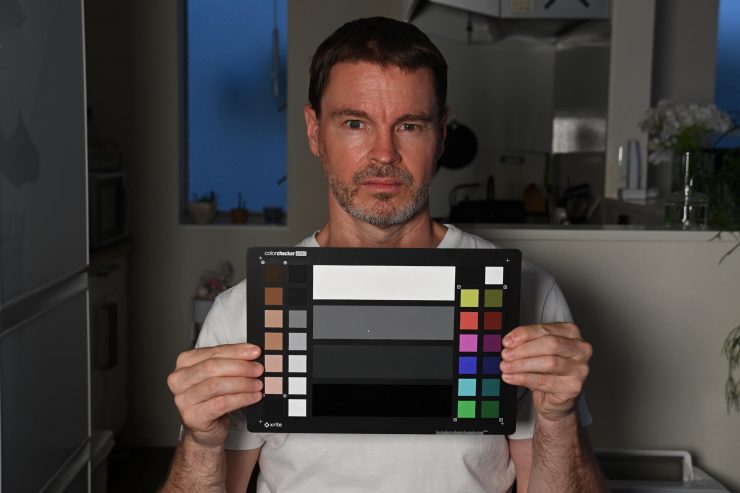
When a WB is done, the Luxli Timpani, Litepanels Gemini Soft, and the Lupo Superpanel Soft Full Color 30 all look pretty good. The Lupo Superpanel Full Color 30 improves after a white balance, but it is behind the other three lights.
5600K (Preset WB)
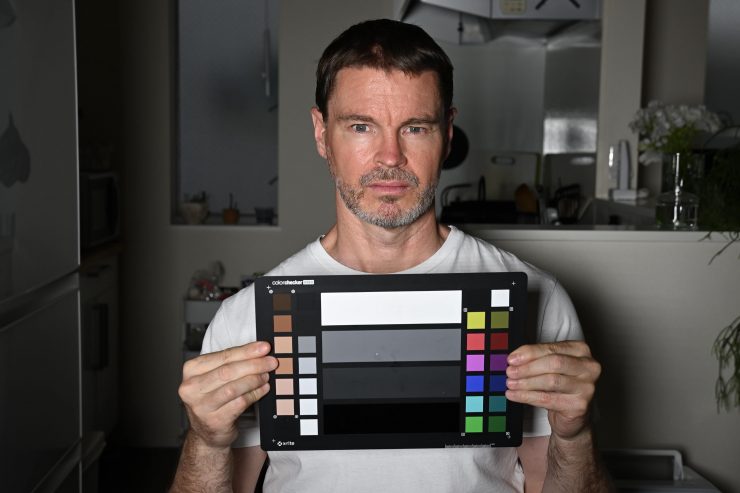
Lupo Superpanel Dual Color 30 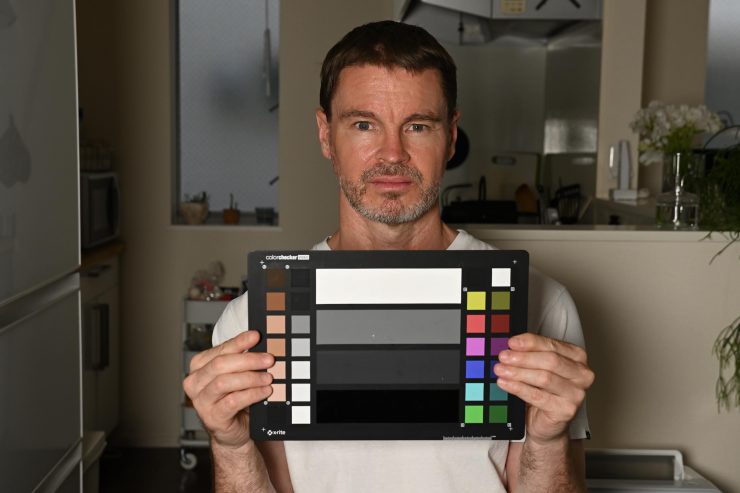
Lupo Superpanel Soft Dual Color 30 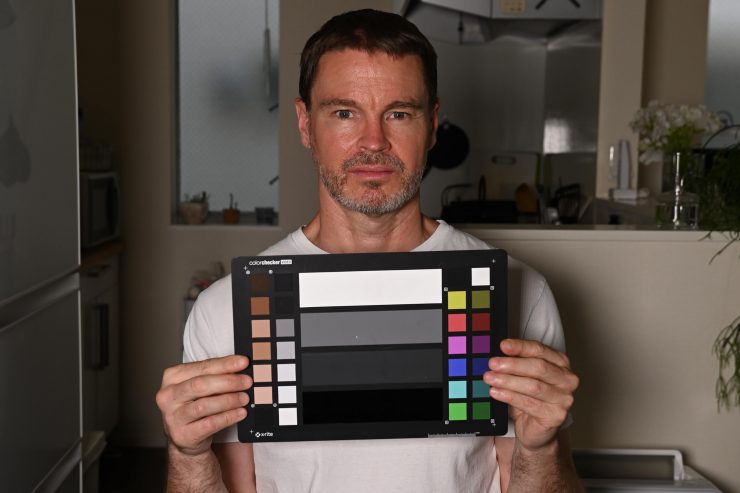
Luxli Timpani 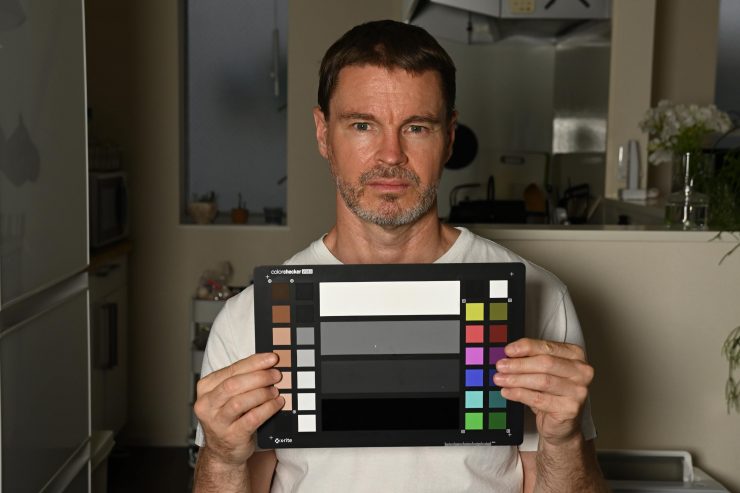
Litepanels Gemini Soft
At a preset 5600K WB you can see that the Luxli has a slight magenta cast, The Litepanels Gemini has a slight tint of green, as does the Lupo Superpanel Soft Full Color 30. White is fairly neutral with the Lupo Superpanel Full Color 30, but you can see how the light’s inability to saturate colors, especially red, is affecting the image.
5600K (WB done)
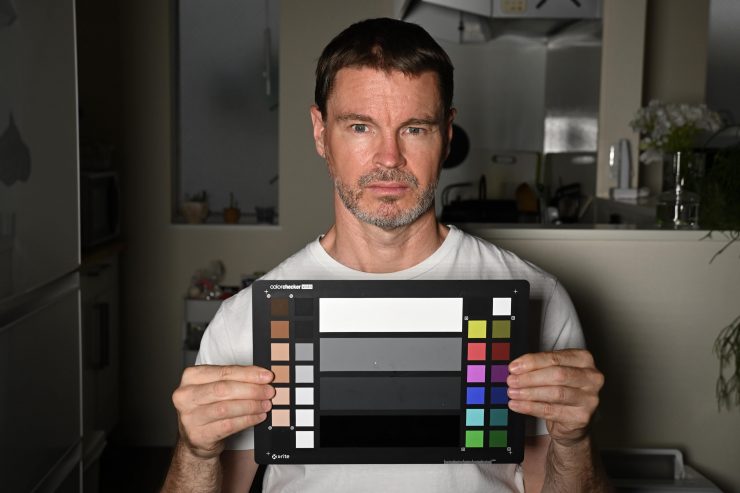
Lupo Superpanel Dual Color 30 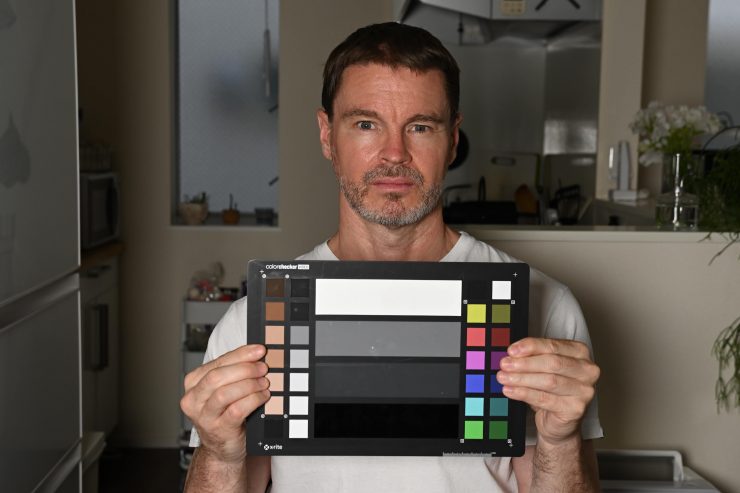
Lupo Superpanel 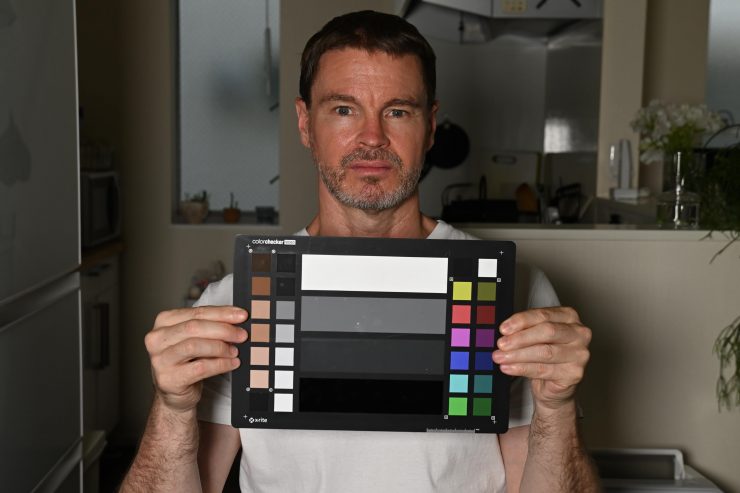
Luxli Timpani 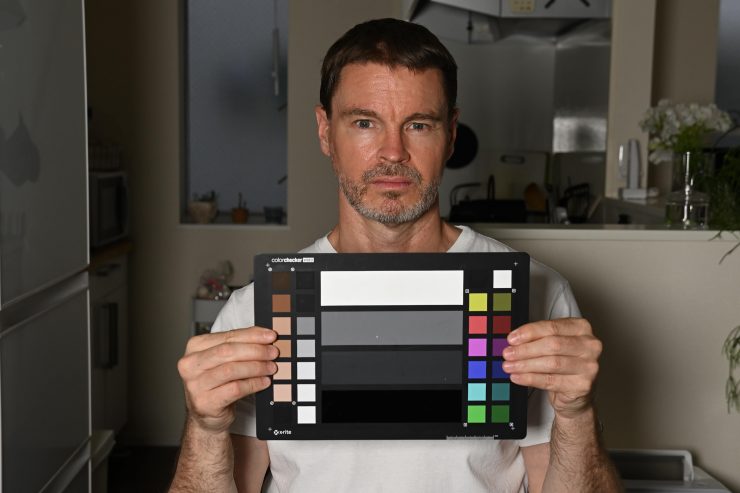
Litepanels Gemini Soft
When you do white balance, the Luxli probably looks the best. Its ability to reproduce a fuller range of the spectrum, and the color red, clearly helps with skin tones. The Litepanels Gemini Soft has a slight green tinge. The Lupo Superpanel Soft Full Color 30 looks pretty good, but it is lacking some red in the face. The Lupo Superpanel Full Color 30 is nice and neutral, but its inability to reproduce red means skin tones look a little flat.
Now, please note that these tests were not designed to make the light look good. We are simply looking at color and skin tone rendition.
Do you actually need an RGBW light?
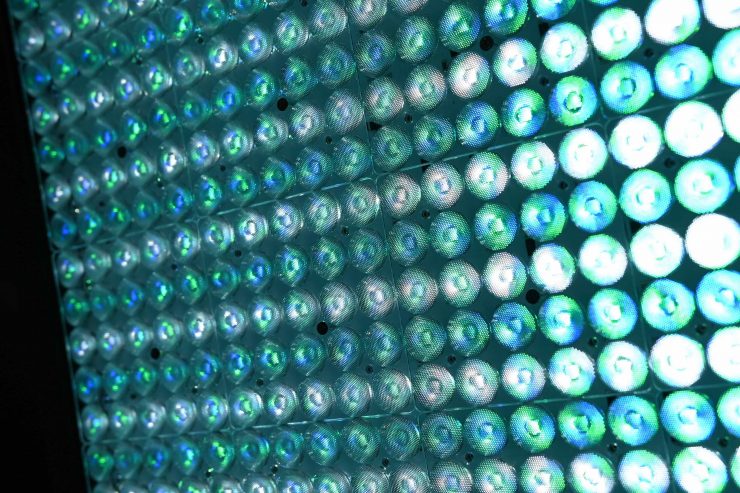
Just because we want something, doesn’t necessarily mean that we need it. Whether you actually need an RGBW light really depends on the type of things that you shoot. If you are primarily shooting interviews then having an RGBW light may not make a lot of sense. However, in saying that, the price point of the Full Color 30 is not that much more than buying a regular Superpanel. In that regard, it probably is worth the extra money to get all of the additional features even if you have no need for them now. If the type of work you do changes then at least you have a light that has the functionality to be used for other applications.
Even if you have no need for creating colors or using effects with your lighting, RGBW lights do give you access to creating a far wider range of Kelvin color temperatures than their regular LED counterparts. Having the ability to dial in a Kelvin color temperature between 2,800 – 10,000 K can be extremely handy.
Price & Availability
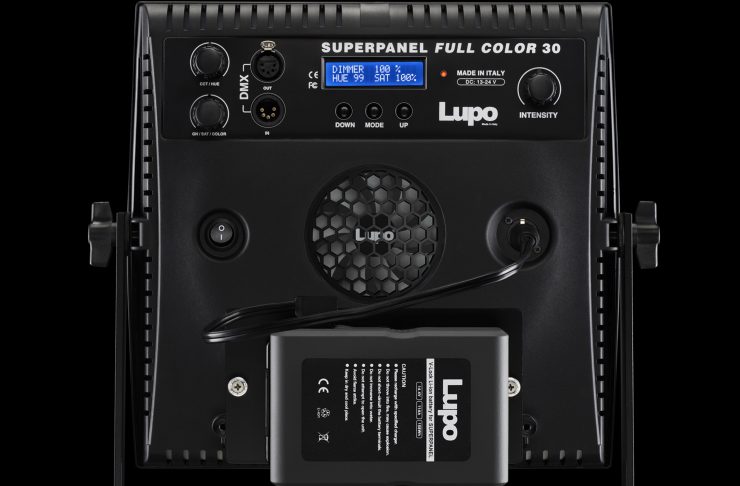
The Lupo Full Color 30, as I mentioned earlier, is available for $1,698 USD, which makes it more affordable than a Litepanels Gemini or ARRI S30-C.
If high output isn’t a massive concern for, both the Luxli Timpani and Rayzr MC 120 offer excellent value for money if you are on a budget and want a 1×1 RGBWW light.
Accessories
Lupo makes a large range of accessories for the Full Color 30. What I love about the Superpanle series is that almost all of the accessories are interchangeable between all of the various versions. So, if you already own another Superpanel fixture and you have some accessories for it, they will work on this light too.
The company has the following accessories available:
- Compact Stand
- Egg crate grid for soft box
- Softbox for Superpanel
- Diffuser for Superpanel
- Barndoors for Superpanel
- V-Mount battery plate for Superpanel
- 160Wh battery
- Battery charger for Lupo batteries
- D-Tap Cable for Superpanel
- Padded bag for LED panels
- DMX Cable
- Clamp for fixtures
- Pantograph 200
- Pantograph 380
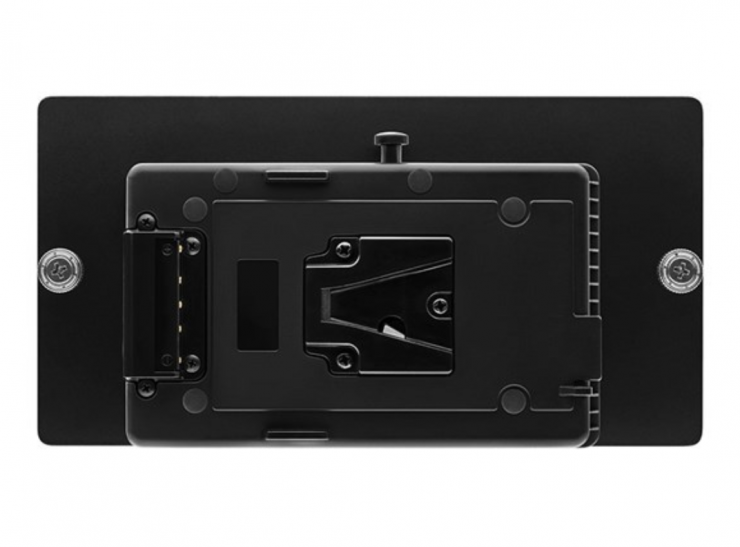
What you do have to keep in mind is if you want to run the Full Color 30 off a camera battery you have to spend an additional $97 USD for the Lupo V-Mount Battery Plate for Superpanel.
Competition
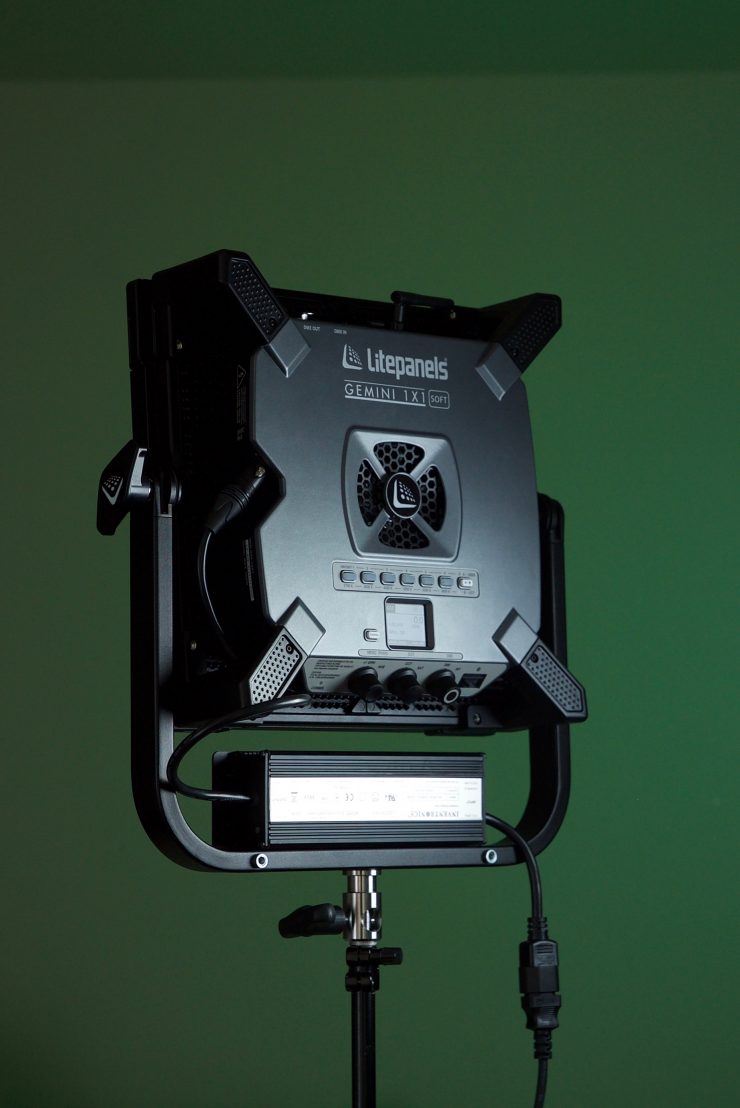
While there are lots of 1×1 panel lights on the market, there still aren’t that many RGBWW lights available.
It’s hard to directly compare the Lupo Superpanel Full Color 30 against other lights, because most of the other options feature a built-in diffusion panel.
Below I’ll list some of the available RGBWW lights that could be viewed as competition and their prices:
| PRICE | |
| Lupo Superpanel Full Color 30 | $1,698 USD |
| Lupo Superpanel Full Color 30 Soft | $1,598 USD |
| ARRI S30-C | $4,710 USD |
| Litepanels Gemini 1×1 Soft | $2,104 USD |
| Luxli Timpani | $999 USD |
| Rayzr MC120 | $849 USD |
| Falcon Eyes D-S811 RGB 1×1 | $1,299 USD |
| FotodioX Pro FACTOR Prizmo 150 | $1,089.95 USD |
As you can see, the Lupo Superpanal Full Color 30 is more expensive than some of the other offerings, but a lot more affordable than an ARRI SkyPanel or Litepanels Gemini 1×1 Soft. At $1,698 USD it is considerably more expensive than the Luxli Timpani and Rayzr MC120.
The ting is, it is a bit hard to compare the Lupo against these other lights because as I mentioned earlier, it is quite a different type of light given its output and beam angle.
Conclusion
The Superpanel Full Color 30 from Lupo is a good alternative to much larger, heavier, and more expensive RGBWW lights. In a lot of ways, this light is quite different from most other 1×1 RGBWW panel lights because it doesn’t feature diffusion and because of its narrow beam angle.
If you travel a lot or need a very portable RGBWW solution that is quick and easy to use for lighting interviews, live crosses, music videos or just about any other application where you require a high output RGBWW battery-powered light (as long as you have access to a large enough battery), it’s a great option. The fixture has an impressive output, and a nice range of features, however, the color accuracy and color rendition could be better.
It has more versatility in a lot of ways than the Full Color 30 Soft, but it does mean you are going to need additional accessories if you want to create a softer lighting source.
Again as I have mentioned numerous times, you do need to be aware of the higher power draw of this light and use an appropriate high capacity battery to remotely power it. For people who travel a lot, this may be a deal-breaker.
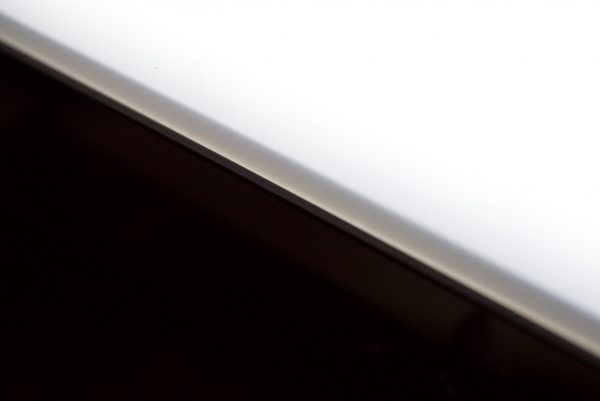
Lupo has a wide array of 1×1 and 2×1 Superpanels to choose from, and this latest version is a good alternative if you want more output and a tighter beam angle, but it does come at the expense of color accuracy.
Like what we do and want to support Newsshooter? Consider becoming a Patreon supporter and help us to continue being the best source of news and reviews for professional tools for the independent filmmaker.

